
REBELLION Issue, no. 198, MARCH 2024

*This is clearly a joke, please don’t take this seriously Student Finance <3
Flicking through this edition of Quench makes it none more apparent how much the theme of rebellion has influenced culture in the past few decades, both on a student level and in a world starting to sit up and realise real action is sometimes required to achieve what it desires.
















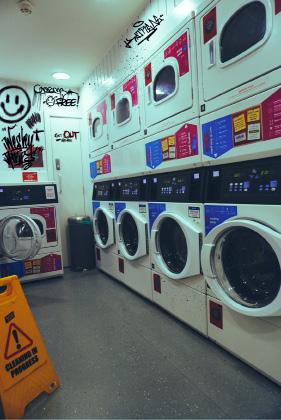
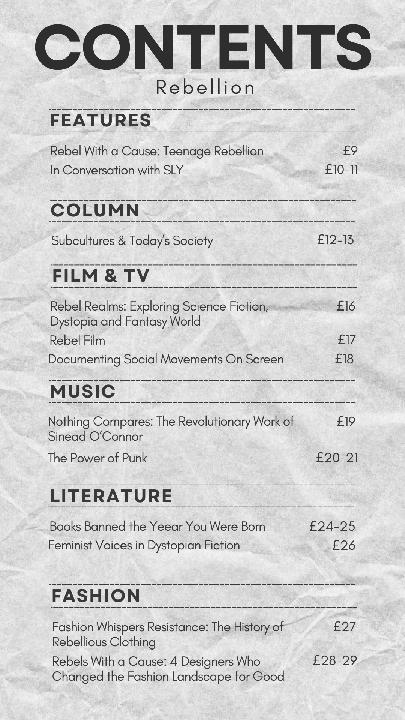
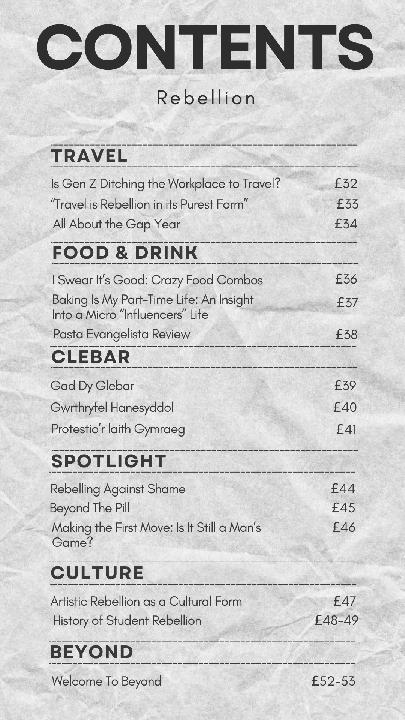 photography by: Laura Nunez
front/back cover & design by: Mia Wilson
back cover modelling: Tom Hewitt
photography by: Laura Nunez
front/back cover & design by: Mia Wilson
back cover modelling: Tom Hewitt
Rebels With a Cause:
Teenage Rebellion
As a kid, you probably did some troublesome things that annoyed your parents. Consequentially, you were warned not to eat sweets before dinner. Or draw on the walls. Or put your middle finger up at your sister (even if she really deserved it). You were told that if you did these things again, something bad would happen. So, sweets were eaten after dinner, the walls celebrated the exile of wonky stick men, and you had to be kind to your sister.
However, something changes as we grow older. We start being told we cannot do things before we have even tried them. Don’t drink alcohol. Don’t do drugs. Don’t drop out of school. While this advice is well intentioned, it can backfire. These warnings, convey a message of distrust. Thanks a lot, mum. I wasn’t going to get plastered tonight but since you trust me so much, I think I will. Sound familiar? It’s a precarious balance: protecting your children from harm while allowing them the autonomy to learn from their experiences.
If respect and trust is lost, everything that was learnt as a child is unlearned, and the once innocent stickmen on the white walls have now evolved into giant genitals plastered all over the school toilets. While some lessons require firsthand experience, some can have dangerous consequences if not avoided. Therefore, to avoid losing trust, open communication and mutual respect is necessary to make informed choices better. If trust is lost, then rebellion is inevitable. words by:
Nicole Halmkan
Many teens decide to rebel. Perhaps to impress their friends, get back at their parents, or simply because they think they should. My own experiences of teenage rebellion came much later in my teenage years, going to parties and sneaking my then-boyfriend into the house when my mum was at work.
I guess I had this urge to try and rebel because I thought that’s what everyone else was doing. I remember going to school after the weekend and hearing, “You’ll never guess what happened at so and so’s house on Saturday night” and being almost hypnotised by the thought of people rebelling against their parents, especially. Partying would be very out of character for me anyway. I never really had an interest in drinking, but I felt I should because that’s what everyone else said they were doing. Therefore, I would look weird if I wasn’t doing that too.
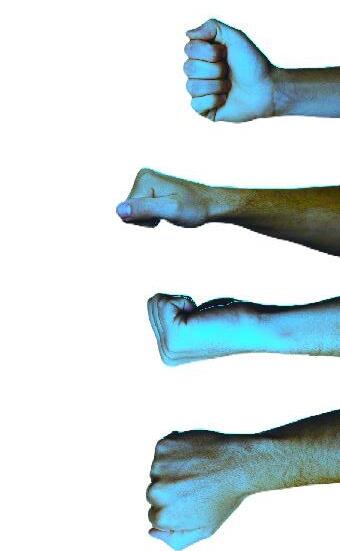
lights, but my mum never wanted me to dye my hair). Although a small act of ‘rebellion’, I knew that my mum would disapprove (she still does).
I feel as though the whole concept of teenage rebellion is largely based on what we think we should be doing because that is the façade that everyone else puts on. The concept of looking ‘cool’ and not being considered ‘weird’ was a constant worry for me in my teenage years, even spanning into my sixth-form years. I got my nose pierced and more ear piercings when I was 19 and then dyed my hair (only high-
I guess reflecting back on my teenage years particularly, I learnt that I shouldn’t have felt that I needed to rebel to fit in. I had no reason to. I suppose it has something to do with the feeling of looking cool, which I know many teens still struggle with today.
words by: Amelia Wollacott design by: Mia
Wilson
Features 9

To express your own
repressed
InConver sation With
SLY



Repressed femininity in such an over exaggerated wayis extremely empowering

10
Cardiff/s only student led drag show talk to us about acts of rebellion and defying stereotypes.
Playing with gender roles and stereotypes is inherently rebellious, with perceptions of masculinity and femininity still deeply ingrained into today’s society. However, the drag community have pushed these boundaries and defied typical gender roles with flamboyance, entertainment, and complete confidence.
Inspired by the liberation and freedom that comes with the expression of drag, two Cardiff University students, Lara Marshall-Ducker and Joshua Salisbury formed SLY, the University’s first student led dragshow. Running on the 23 rd and 25 th April at the Student Union, the show will consist of multiple drag acts such as lip synching, dance, and comedy. The motivation to create the show came from Lara’s desire to fundraise for Mind, her chosen charity to donate to through her participation in this year’s London Marathon.
I wanted to know more about why the two students chose a drag event as their primary fundraiser, so I conducted an interview with Lara to gain some of her insight and thoughts surrounding the art form.
What firstly drew you to drag as a ‘rebellious’ form of expression?
I think what I love about drag as an expression so much is the complete ability to be yourself, even in a manner that some would consider dramatic, and not feel scrutinised. To express your own repressed femininity in such an overexaggerated way is extremely empowering.
Why did you choose Mind as a charity to fundraise for?
In my opinion, one of the most important things about Mind as a charity is the resources they have to offer. There is on hand support, links, and information for anybody struggling with a mental health issue - or anybody wondering how to help somebody with one. Mind is a really important charity to me, and by fundraising it just means that it can go on existing for longer and offer wider support, which is
fundamental to the health of the UK.
How do you think drag can help defy and rebel against stereotypical gender roles? Do you think this is a positive thing?
I think so. In this age gender stereotypes are so disregarded anyway amongst young folks, so I think any artistic expression like drag can only strengthen this breaking away from traditional gender stereotypes, which have worked to repress the very same community that drag empowers.
Why do you think students at Cardiff will enjoy the show?
With the lack of LGBTQ+ events, I think our drag event is undoubtedly important. It is great to have the LGBTQ+ society being one of our sponsors, and I’m sure their input will attract many students here at Cardiff who will enjoy the show.
Lastly, what kind of demographic do you expect to attend the show? Do you think many non-LGBTQ+ people will feel drawn to the show?
Although we expect many members of the LGBTQ+ community to attend the show, I would hope that many people aside from the community would also feel welcome to join. This doesn’t only mean the friends and family of our coordinators, but anyone with a genuine love for all artistic expressions. It will be a fun time, with booze and samosas!
The show will take place at Y Plas, Cardiff Student’s Union, on the 23rd and 25th April. Come down, bring your friends, and enjoy some of our students’ finest talent, all whilst donating to a good cause!
Further Information can be found on Instagram @slycardiff interview by: Izzy Walsh design by: Alanya Smith




Features


Column 12

Subcultures have existed for as long as time itself so it’s no surprise that they are so influential to the interworking of our society. Perhaps even less surprising is the fact that, as society continues to develop year upon year, subcultures do too, with new groups emerging on our feeds and influencing the latest trends and ways we behave. But what are subcultures? And do they still have a place today?
Subcultures are small groups within larger society that tend to deviate from the standard norms and values. They share the same beliefs and values, and are often aligned by fulfilling a particular way of life. These kinds of groups have always existed, however discourse on them only began to emerge in the 1920s. Many sociologists at this time suggested that subcultures were rebellious groups, deviating from standards as a form of resistance. In some cases, this is true. But often, subcultures are just a form of distinction, with members coming together and uniting over a shared interest.
When people think of subcultures, the stereotypical ideas often spring to mind first: punk, goth, mods and rockers. These groups are huge and extremely influential to our understanding of how subcultures operate and how they grow to be distinguishable from wider society. One of the most
important factors to consider when looking at a subculture is the way that they symbolically represent themselves. From the ripped and leather-bound fashion of punks, to the horror-rock music of goths, each subculture tends to be synonymous with a certain type of aesthetic that sets them apart from the rest. But while fashion, makeup, hair and music were once used by these groups as a statement to rebel and resist the mainstream, the two have now become largely intertwined.
The influence of these historic subcultures on how mainstream society operates today cannot be underestimated. They may have started as an act of rebellion, but they soon grew into much more than just this. Today, the aspects of subcultures that once divided opinion and caused a scene have become part and parcel of our culture. From fashion items to music genres, so much of what we consume now is thanks to these longstanding subcultures.
Because of this, the lines between what’s standard and what’s deviant have now largely blurred. Back in the 60s and 70s, members of subcultures would have been easily identifiable. However, their influence on our trends today makes it harder to know who is genuinely making a statement, and who is just jumping on the bandwagon. This, coupled with the rise of social media, has changed the scope of how we think of subcultures as a whole.
As social media communities grow and evolve, subcultural communities have begun to manifest themselves in different ways. TikTok, for example, has seen hordes of people attaching themselves to the latest aesthetic trends, and as a result, huge communities have been born. From clean girls to cosplayers, cottagecore to booktok, many of the groups we see on our feeds today are not necessarily rooted in a place of rebellion, but the way they are positioned in our society feels reminiscent of how many subcultures got their start. These new TikTok communities have, just as ‘OG’ subcultures did, gone some way in changing the landscape of what is on trend and current. They’ve appeared almost from nowhere and swayed public opinion, with people either loving or hating them, but buying into them in some way.
So, whether you align with the deviant values from back in the day, or simply view yourself as part of a TikTok community, there is no denying that subcultures are all around us. They are continuously evolving and morphing into different strains. Their influence and impact on wider society is astounding, and without these groups of people who are unafraid to push the boundaries, we would not be where we are today.
words by: Maddie Balcombe design by: Mia Coley
Column 13
 photography by: Adam Breen
photography by: Adam Breen


 photography by: Adam Breen
photography by: Adam Breen

Rebelm Realms
Exploring Science Fiction, Dystopia and Fantasy World
Suzanne Collins once stated that her inspiration for The Hunger Games involved channel surfing one night, in which she noticed the stark ignorance of the contradiction of media – on one channel, a reality television programme in which individuals competed for a grand prize, and live, jarring footage of the Iraq War. These two elements, mixed with heavy inspiration from Greek mythology, created the dystopian North-American country of Panem, in which twelve districts would annually select a boy and girl through a lottery to fight to the death in a glorified, televised pageant.
Residents of the Capitol, the nucleus of Panem that has complete control over the surrounding districts, anticipate the bloodshed of pre-pubescent, innocent, malnourished children in the same way we do Love Island. Placing bets on the lives of their social inferiors, comparing odds like it’s the Grand National – sounds harrowing enough in its concept yet, not dissimilar from the reality we find ourselves in. We live in a world already too desensitised to war and are bound by the chains of capitalism to do anything about it. 16-year-old Katniss Everdeen volunteers in place of her younger sister, whose singular entry into the ballot is unfortunate enough to have been swept up by the glove of a materialistic, hyper-enthusiastic Capitol escort. Again, that familiar class divide, in which the rich continue to benefit from the exploitation of the poor. Each district provides to the Capitol, be it lumber, electricity, or coal. This labour is crucial to the survival of such a system, a “fragile” one, “if it can be brought down by a few berries” as Katniss says.
Despite her strong hatred for the Capitol (who has exploited her loved ones and were the choreographers of a butterfly effect that led to her father’s death in the coal mines), Katniss never intended to be the rebel that caused an uprising and the eventual overthrow of such a system. The leader of the rebellion, Alma Coin, uses Katniss in a similar way to President Snow – as a pawn in a much bigger plan, a piece in her game. All Katniss truly wanted was to save her sister, which proved futile at the hands of the rebellion in the finale of the series.
Still, her protection of Rue, her double-suicide attempt in her first games, both events sparked that little bit of hope that the districts needed, and one three-finger salute at a time, hope became stronger than fear, and the decades of turmoil and exploitation suffered by the citizens of Panem was toppled by the actions of the unlikely teenage girl from the Seam.
So, if you have ever believed there was no true point to standing up for what you believe in, Katniss Everdeen
and her story of determination and love will always stand to remind you that there is always hope, always a chance, and any act of defiance is important, no matter how feeble it may seem.
words
by:
Tegan Davies
Words by: Katie Storrie
Divergent is a film adapted from Veronica Roth’s bestselling novel, and stars Shailene Woodley and Theo James. It showcases themes of identity, choice and resistance to society, combining the realms of Post-apocalyptic Science Fiction and Dystopian realms. The film follows Tris Prior, the protagonist, who lives in a futuristic Chicago, where people are divided into five fractions based on personality traits: Amity, Abnegation, Dauntless, Candor and Erudite.
Tris soon learns that she is a Divergent, which means she does not fit into any of the five fractions. A Divergent is considered a threat to society, due to the rigid social order. Entering adulthood, she must choose the fraction to join for the rest of her life. She decides to leave her original fraction, Abnegation, to join Dauntless. This fraction is not for the faint of heart, and she undergoes a brutal initiation process, completing tasks that challenge the strength of human nature, both mentally and physically. Divergent celebrates the power of individuality and the courage to stand up for one’s beliefs, even in a totalitarian regime. It allows certain characters to challenge the status quo and to resist conforming to the oppressed society.
Rebellion is a central element to Divergent. Right from the start, Tris, goes against the social norms of society, this includes changing her name and getting a tattoo to pay tribute to her original fraction. Her relationship with Four, is centred around secrecy and mystery. They combine their unique differences together, becoming a perfect fit together, both romantically and as partners in overthrowing the authorities. Yet the romance is equally an act of rebellion in itself! Tris and Four work together to expose the corruption and injustices that threaten freedom and future of the world, constituting as an act of rebellion. Tris embraces her own Divergence, so she can take control of her identity and actions. This is incredibly inspiring to people watching the theme as it show the importance of take control of your own values and identity, even if it contradicts societal norms.
Ultimately, it is a fast-paced, high-action film that engages views with its thrilling plot, compelling characters, and thought-provoking themes.
words by: Katie Storrie design by: Alanya Smith
Film & TV 16

Rebel Film
In an age where rebel film and tv is growing and diversifying, feminist film adaptations are becoming of the utmost importance to the screen. Feminist film may expose sexist themes like in Gil Junger’s 10 Things I Hate About You (1999), a rewriting of Shakespeare’s misogynistic Taming of the Shrew. It may also give voice to the women in history, creating series like The White Queen which allowed the story of Elizabeth Woodville to be brought to the forefront of the Wars of the Roses. But a truly revolutionary piece of cinema that presents the complexity of the female position is Greta Gerwig’s adaptation of Louisa May Alcott’s Little Women (2019).
Adapting a piece of literature published in 1868, Little Women follows the story of the four March sisters: Meg (Emma Watson), Jo (Saoirse Ronan), Beth (Eliza Scanlen) and Amy (Florence Pugh). Each sister has different ambitions and Gerwig masterfully recognizes the significance of each one. Her film does not prize the feminine rebellion as only being in just one form; she highlights the value of unrestrained female aspiration in a myriad of examples using colour, landscape and symbolism to spotlight the diversity of each sister’s desires whilst uniting them through their portrayal of the feminine dream. This is especially poignant in Meg’s assertion that ‘just because my dreams are different to yours, it doesn’t mean they’re Unimportant’.
Gerwig’s film captures the duality of the feminine spirit. She utilises the story written by Alcott, who was a suffragist herself, and highlights the versatility of women. Rather than purely concentrating on Jo’s independent mindset so reminiscent of the suffragists, she also explores Meg’s dreams of romance and family as well as Beth’s quiet musical ambition. What is most poignant to me however is her presentation of Amy. Perhaps, as a woman, I understand her sentiment of ‘the world is hard on ambitious girls’ or that I also ‘want to be great or nothing’, but Amy’s unwavering desire to be something in a world that wishes women to be nothing perfectly captures the feminine experience. If she cannot be great as a painter, she will be great as a wife and as a mother; Amy truly represents the duality of woman and her ambition.
This adaptation of Little Women has in its heart a portrayal of the multitude of roles women can play in the world if given the opportunity. Its feminist undertone presents the flexibility of women’s nature as writers, musicians, mothers, painters, teachers and so much more. As Jo says towards the film’s closing, women ‘have minds, and they have souls, as well as just hearts’.
words by: Kayleigh Lloyd photography by: Adam Breen design by: Alanya Smith
Film & TV 17

If you think of Hollywood’s retelling of the ‘Space Race’, you might conjure up images of American patriotism and Neil Armstrong’s first steps on the moon. You’re perhaps less likely to think of unfavorable images of racial and gender injustice. However, through watching 2016’s Hidden Figures, this may no longer be the case.
The movie follows three female African-American mathematicians (Katherine Johnson, Dorothy Vaughan and Mary Jackson) on their quest to fulfill a NASA mission that will send astronaut John Glenn into orbit. It details their contributions to NASA while, at the same time, emphasizing what the glorified depictions of ‘Space Race,’ history failed to mention.
Documenting social movements on screen
The three women are shown to be incredibly intelligent, yet constantly overlooked and underappreciated. We see them facing difficulties integrating into NASA’s white maledominated environment and being ruthlessly belittled for their ethnicity and gender. This is especially evident through the monologue where Katherine Johnson (played by Taraji

Henson) talks about her experience with racial segregation and discrimination. She emotionally exclaims that she is underpaid and discriminated against to the point that she must live off a pot of coffee. Not only this, but that this very pot of coffee is not touched by her white co-workers due to racist assumptions. It is a poignant scene which perfectly encompasses the movie’s overall message and that is that ‘Space Race,’ history is not as honourable as it may seem.
Thus, the movie seems to question Hollywood’s storytelling abilities in the sense that it shows how certain ideas (such as nationalism) have prevailed at the expense of others (such as racial and gender inequalities). It also seems to remind us that Hollywood has never taken a neutral stance when showing real life events and that certain narratives may override others. This proves to be impactful for the future of Hollywood as it shows how we can hold prior retellings to account and encourage viewers to recognise the many injustices in society. This means that, in the future, one can also hope for equal representation.
words by: Chloe Thomas – Evans
design by:
Billy Edwards
Film & TV
18


On the morning of 7th August, 2023, a sprawl of white letters appeared on a grassy outcrop of County Wicklow, Ireland. ‘ÉIRE ♡ SINÉAD’ inscribed in the landscape seemed a fitting tribute to the passing of the late, great Shuhada’ Sadaqat - better known to the world as Sinéad O’Connor - one week previous. As a musician, a poet, an activist and a public figure, the loss of O’Connor has left a deep scar on the cultural psyche of the British Isles.
What I find so striking about O’Connor’s work is her strength; throughout her career, she refused to be pushed into a box, stood fast by her beliefs even if they rendered her a social pariah. She lived as she preached. Her protest was not mere performance - she knew instinctively that waving a Pride flag onstage, or posting a black square on Instagram, was not enough to encourage social change, and had a sense from a young age of her responsibility as a public figure to fight for what she believed in. Her shaved head became a symbol of her rejection of femininity; her boxy, ill-fitting clothes in combination with her incisive criticism of the world she inhabited made her simultaneously a figure of discomfort and inspiration to people across the world.
I recently watched her interview with Arsenio Hall in 1991, in which, aged just 24, she speaks with absolute conviction about her refusal to accept various music industry awards. She says: “... I believe very much that the music industry as a whole is concerned mainly with material success, and a lot of artists, I think, are responsible for encouraging the belief among people that material success will make them happy. And I think one of the ways that the industry encourages commercial success and materiality is by having award ceremonies which very much honour those who have achieved material success, rather than people who have told the truth…”. She was openly critical of the music industry and its beneficiaries, who spoke about ‘peace in the Middle East’ while doing nothing to address the causes of the Gulf War. Listening to her speak on performative activism, years before the term was popularised, brings into focus how far ahead of her time she was, and how far we have still to go - particularly in the wake of a string of award seasons in which little to no mention was made of the ongoing violence in Gaza.
Apart from action against the music industry, O’Connor was also a prolific activist in all areas of life. In part this resulted from her own experiences. She was a deeply troubled woman, had been abused at the hands of her mother and later the Church, and had grown up in an Ireland still suffering from poverty, addiction and violence, which she would later credit as a symptom of generational trauma caused by centuries of colonial British rule in what is possibly her most radical and intelligent track, ‘Famine’. She fought for abortion rights, the ideal of a United Ireland, racial and gender equality, pacifism, and freedom, both within her art and as a citizen, inspiring not just other artists but other activists to do the same.
Perhaps most famously, her performance on Saturday Night Live in 1992, in which she staged a protest against the Catholic Church’s complicity and active involvement with child abuse, led to numerous attacks in the press and from the public, and cast a cloud over her career which would not lift for decades. Responding to this “career-destroying” moment, O’Connor merely re-affirmed her beliefs, recasting herself from popidol to protest singer with ease. She understood music, and her position as a musician, to be a way of speaking truth to power, and refused to let the machinations of an industry she viewed as corrupt and materialistic to sway her from this goal. In 2020, Time magazine would go on to name her the most influential woman of 1992.
Far be it from me to agree with Morrissey - the man is a racist chauvinist pig, and I wish him all the worst - but in his own tribute to O’Connor, he got one thing right. ‘She refused to be labelled’, he opined, and for that reason the music industry consistently failed her. She was without support, often actively hated, and yet her death was met by an outpouring of praise for the very outspokenness which had ostracised her from the mainstream. It’s a sad thought that a true rebel’s power and impact is only acknowledged after their death - but perhaps it is better that O’Connor’s extraordinary contributions to culture be recognised late than never.
words by: Polly Brewster design by:
Alanya Smith
THE POWER OF PUNK
Music 20 !
! ! ! ! ! !
!
A black motorcycle jacket, spiked hair, ripped skinny jeans, a t-shirt held together with safety pins and the latest Sex Pistols vinyl. The iconic symbols of rebellion against the mainstream. Punk had finally stepped onto the scene, donning Dr. Martens of course.
The mid-1970s saw a rejection of the assumed pretentiousness of mainstream rock. Those who had once hailed the likes of The Beatles and The Rolling Stones could no longer relate to their global superstardom and extreme wealth. Instead they found solace in rebellion against the establishment. A new type of music reflected the societal issues and inequalities that plagued the life of the ‘everyman’.
Punk went beyond just escapism or entertainment. It was the embodiment of anarchy. The Damned released the first official UK punk single ‘New Rose’ in 1976. Not long after came the Sex Pistols with ‘Anarchy in the UK’ and they were truly looking to ruffle some feathers. Their first appearance on Thames Television Today show saw Johnny Rotten swearing with glee. Punk had officially upset the norm and given a big middle finger to authority.
Punk lyricism armed itself with aggression, hostility and boldness. The infamous song ‘God Save the Queen’, released in 1977, rejected and criticised the monarchy with fervour. Lines from the song - ‘the fascist regime’ and ‘she ain’t no human being’ - influenced designer Vivienne Westwood, who produced a t-shirt of Queen Elizabeth II surrounded by Sex Pistols lyrics. This collaboration was seen as a direct affront to British patriotism and the establishment and went on to impact punk fashion.
However, one of the first big socio-political movements associated with punk was Rock Against Racism. Established in 1976 as a collaboration of activists and musicians protesting racism in the music industry and the rise of racial street attacks in the United Kingdom. The Clash, The Ruts, Tom Robinson Band, Sham 69, and Stiff Little Fingers playing gigs in support of Rock Against Racism in the UK in 1978-79.
This movement led to the creation of Rock Against Sexism, a campaign dedicated to challenging misogyny in the rock industry and the world as a whole. Post-punk bands such as Spoilsports, Delta Five and Gang of Four headlined the first large gig and part of the profits were donated to The National Abortion Campaign, a campaign which fought against the restriction of abortion access to women in the 1970s.
Rock Against Sexism then went on to influenced riot grrrl, an underground feminist punk movement. Bands such as Bikini Kill, Bratmobile and Heavens to Betsy wrote songs which addressed domestic abuse, rape, sexuality, patriarchy, anarchism and female empowerment. The riot grrrl movement not only had a place in the music scene but went onto influence an internet-based fourth wave of feminism and delved head first into direct action activism.
It’s clear punk goes beyond music. Punk simply isn’t punk without a chorus entrenched in political ideology, a verse rejecting the status-quo, and a bridge demanding anarchy.
words by: Polly Brewster design by: Mia Wilson
21
Music

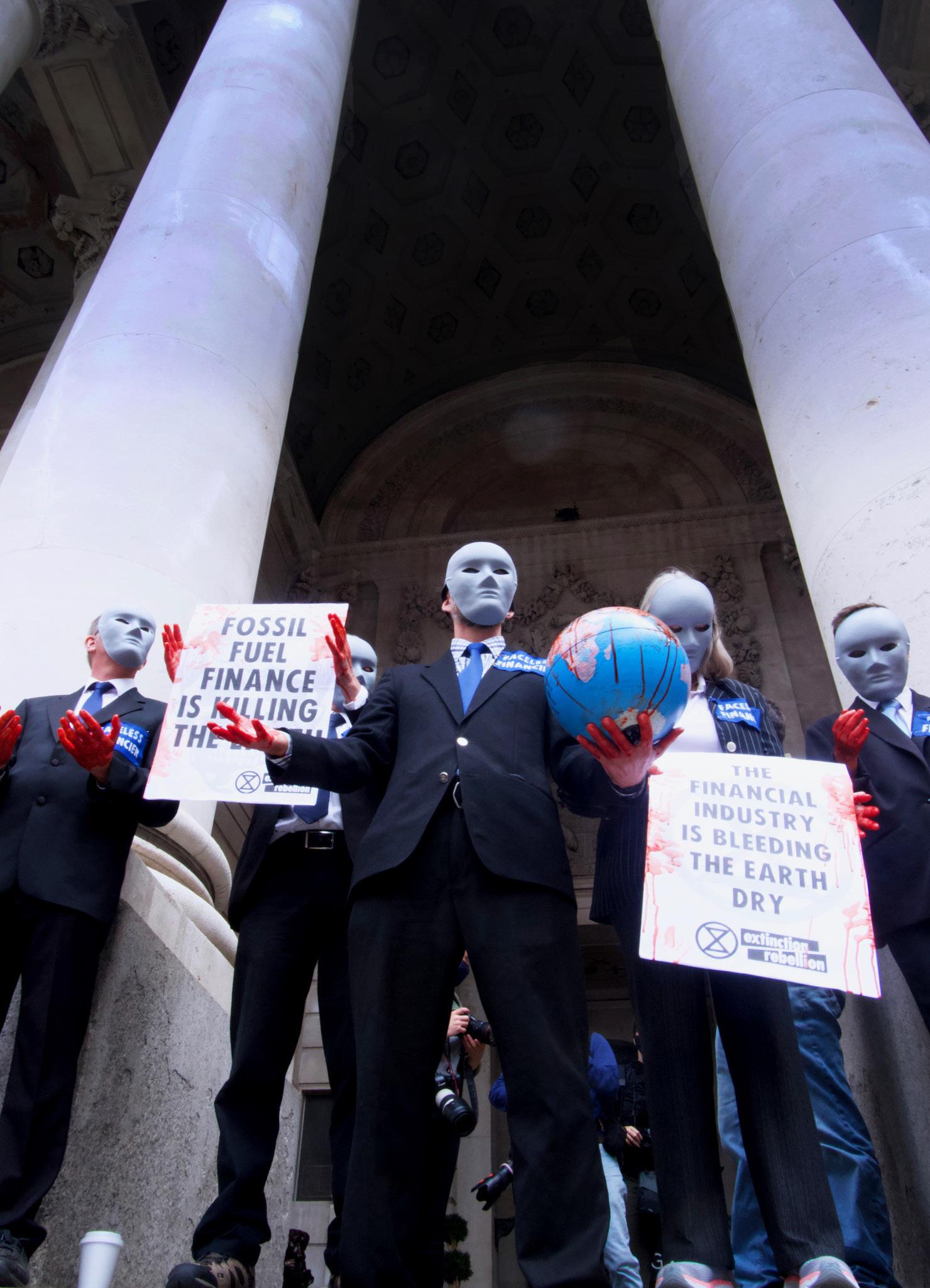 photography by: Adam Breen
photography by: Adam Breen
 photography by: Mia Wilson modelling by: Tom Hewitt
photography by: Mia Wilson modelling by: Tom Hewitt
BOOKS BANNED THE YEAR YOU WERE BORN
2002 - I Know Why The Caged Bird Sings
Born in the summer of 2002, some very famous book titles were banned. One example is Maya Angelou’s I know Why the Caged Bird Sings (1969). In an Autobiography in the form of a coming-of-age narrative, Angelou responds to the abuse and racismshe endured as a child. Claiming the book includes ‘offensive language’ the book ranked sixth on the US list of most banned books between 2001-2010. As a highly respected author, winning a Emmy, National Book Award, and even reading her works at President Bill Clinton’s inauguration in 1993, Angelou still faces prejudice against her work. It has been removed from he school curriculum across many states, due to it being considered ‘inappropriate’ for middle school children. Some protestors even argued it was ‘likely to corrupt minors’. Despite this, Angelou’s work continues to be a celebrated narrative, to raise awareness of racism and prejudice.
words by: Amelia Wollacott
2002 - Animal Farm
The satirical novel was first published by Orwell in 1945. It follows a group of anthropomorphic animals who rebel against their human farmer, to create the ideal society where animals could be equal, happy and free. Orwell’s fable sheds light on how those in power ultimately corrupt, perverting their democratic promise of revolution. There are many counties where Animal Farm has been banned, due to its criticism of communism. In 2002, the novel was banned in schools in the United Arb Emirates due to themes of ‘indecent images’. Orwell himself said, “ I am convinced that book would be more good if it were allowed circulation.” And I agree, I feel that censorship is just another rung in the ladder to an oppressive society. The novel may contain controversial ideas, but ultimately serves as a moral waring. Readers mustn’t be restricted of vital resources of knowledge.
2002 - ANIMAL FARM
words by: Zoe Lott
Literature 24
!?
2003 - Brave New World
2004- The Perks of Being A Wallflower
In the dystopian tapestry of Brave New World, Albous Huxley envsioned a society governed by pleasure and conformity. Huxley’s work faced challenges in 2003, particularly in the South Texas Independent School District in Mercedes, as a result of it being banned. The district allowed alternatives to be given upon request as it was deemed ‘concerning’ due to the inclusion of themes such as sexuality, drugs and mental health. This seems to be an extreme and likely misguided attempt by parents to influence their children’s thoughts, since Brave New World depicts a society where books are forbidden, creating a paradoxical situation of censoring a censored book. I feel as if the book opens the minds to the thought of future and what could be done if we aren’t careful. It shows how rebellion is sometimes done best in smaller doses, just do nobody has to endure a society conditioned by technology.
words by: Neve Powell
Challenged by the Memorial Library System of Montgomery County Texas, Stephen Chbosky’s, The Perks of Being a Wallflower was subjected to an attempted ban throughout 2004. Chbosky’s work, alongside fifteen other young adult novels were targets due to their gay positive themes that systems views as unsuitable for young readers. This harmful reasoning didn’t hold firm and the book was swiftly reintegrated into libraries and became easily accessible again to its targeted young readers. Attempting to ban such a beloved novel that many find relatable to their own high school experiences was never going to be a success. Many readers view this piece of literature as a modern classic. The novel’s gay positive theme should be recognised and praised, rather than ridiculed and undermined. As a turn-of-the-century work that embodies modern ideals, the novel needs to increase its accessibility, not reduce it.
words by: Millie Higgins
design by: Isla McCormack
2004 - The Perks of Being A Wallflower
In my mind, books are everything good in the world. Being able to be transported into a different world because of some black staining on a sheet is witchcraft, no two ways about it. Perks Of Being A Wallflower was banned from school reading lists in May 2003, the same month I was born. The reason was the ‘offensive’ content inside. The book is written as letters from the protagonist’s, Charlie’s, perspective. He’s a 15-year-old boy and he’s just start high school. We learn information about him in a piecemeal way, watch him go to parties, drink, and take drugs and discover his sexuality. By the end we learn that he’s been abused by a family member. I really enjoyed this book, it really feels like it was written from a struggling 15-year-old. This was the 10th most banned and challenged book in the US between 2000 and 2009.
words by: Poppy Adams
Literature 25
words by: Julia Harink
The dystopian novel 1984 by George Orwell is regarded as the ultimate example of its genre, yet the female voice in the novel is diminished under the depiction of a highly patriarchal regime. When reading the novel for the first time it is clear that no women are in power or have any say in political leadership. A first-time reader of the novel would notice that the women have no political influence or authority and are only valued as wives, with their reproductive rights decided for them. This under-representation, despite the fact that women clearly exist in this dystopia, allows only a few women to be notable enough to be named. We mainly rely on the character of Julia as our insight into womanhood in Oceania. To the regime, Julia is portrayed as likeable, the perfect depiction of femininity and a proud member of the Junior Anti-Sex league. However, she is also a key part of Winston’s storyline through her rebellious nature in which she rebels through having sex, the exact thing that she is meant to renounce. Julia is conscious of the state’s control, but she lacks the motivation to challenge it, making her irrelevant to the male-dominated resistance movement that drives the story.
Reading this novel in 2024 allows us to reconsider the gender roles in such an important text. Sandra Newman offers a revisionist reading of 1984 in her 2023 novel Julia. The need for this second novel, written from Julia’s perspective gives us an insight into what Oceania was like for women. It brings to light the importance of her character in the original novel as not just a catalyst for Winston’s rebellion, but a rebel in her own name.
design by: Mia Coley

words by: Nicole Halmkan
I enjoyed every aspect of The Maze Runner by James Dashner, but it lacked a representation of female voices. In contrast, The Knife of Never Letting Go by Patrik Ness, which follows a similar premise, excels in giving women voices.
The Maze Runner showcases predominantly male characters. Teresa is arguably the character that saves the novel from complete underrepresentation. However, it is worth noting that for most of the novel, she is unconscious serving only as a symbol, rather than an active charactergiving her no voice. Ava is another female character, but her voice becomes hard to resonate with as she is the antagonist.
The female voice is stronger in The Knife of Never Letting Go. Notable female characters include Viola, Todd’s mother and Hildy, their voices show strong female representation, in a town where nearly all women were killed off by a germ. This setting is vital to the plot; it sets up Todd’s journey in discovering the misogyny and violence against women that is rooted in the town. The journey itself is enhanced by the input of female perspectives. Viola becomes Todd’s companion and showcases her resourcefulness, to help him learn about the secrets of the oppressed world. Todd also immerses himself in the female voice, by reading the journal of his deceased mother.
Ultimately, The Knife of Never Letting Go succeeds in portraying female voices. However, The Maze Runner fails to do so. My suggestion is to make it a novel featuring ‘The Female Glade’.
Literature 26
Fashion Whispers Resistance: Fashion
words by: Olivia Griffin design by: Mia Wilson
Throughout history, clothing has been a powerful form of expression, used to convey social status, cultural affiliations, and personal identity. Yet, perhaps its most potent role has been as a vehicle for rebellion. From ancient civilizations to modern subcultures, individuals have utilized clothing to challenge societal norms, provoke change and assert their autonomy.
Ancient civilizations laid the groundwork for rebellious attire, with clothing often symbolizing defiance against societal norms. In ancient Rome, citizens known as ‘plebeians’ distinguished themselves from the aristocracy through simpler garments, challenging the opulent attire of the elite. In ancient China, the adoption of specific colours or styles by certain groups signalled dissent against imperial rule, showcasing the power of clothing as a tool for resistance.
In the 15th century, amidst the turmoil of the Hundred Years’ War, Joan of Arc emerged as a symbol of unwavering courage and defiance against the status quo. Clad in the attire of a soldier, she defied societal expectations of femininity and embarked on a quest to liberate France from English domination. Joan’s armour became emblematic of her defiance, challenging traditional gender roles and inspiring generations to come.
Fast forward to the opulent courts of 18th-century France, Marie Antoinette - the archetypal queen of decadence - redefined rebellion through fashion. Amidst the rigid etiquette of the Versailles court, Marie Antoinette used her wardrobe as a tool of subversion, skewing the standard conventions of royal attire in favour of extravagant gowns adorned with ribbons, lace, and feathers. Her audacious style not only defied the norms of her time but also sparked controversy

The History of Rebellious Clothing
and resentment among the French population, who saw her lavish spending as an emblem of royal excess.
As societies evolved, so did the forms of rebellion expressed through clothing. The Renaissance period witnessed the emergence of flamboyant attire challenging medieval austerity. Figures like Girolamo Savonarola condemned luxurious clothing, sparking movements such as the “Bonfire of the Vanities,” where expensive garments were publicly burned as a symbol of moral defiance.
Fast forward to the 20th century, and rebellious clothing became synonymous with countercultural movements. The roaring twenties saw the rise of the flapper dress, symbolizing female liberation and challenging traditional gender roles. Meanwhile, the punk movement of the 1970s embraced torn fabrics, safety pins, and provocative slogans to rebel against mainstream society. Icons like Vivienne Westwood spearheaded this movement, using her designs to confront traditional expectations and ignite a cultural revolution.
The 1960s and 70s marked a pivotal era for rebellious fashion, with figures like Jimi Hendrix and Janis Joplin epitomizing the spirit of nonconformity through their psychedelic attire. Tie-dye shirts, bell-bottom jeans, and fringe jackets became symbols of the counterculture, rejecting the conservative values of the preceding decades and embracing a philosophy of peace, love and individuality.
In recent decades, rebellious clothing has continued to evolve, with streetwear emerging as a prominent form of cultural resistance. Brands like Supreme and Off-White have transformed hoodies, sneakers and graphic tees into symbols of rebellion, challenging the exclusivity of high fashion and transforming style for a new generation.
Social media platforms have amplified the impact of rebellious clothing, allowing individuals to connect around shared style identities. Hashtags like #OOTD (Outfit of the Day) alongside short-form video content have empowered users to express themselves authentically, transcending the boundaries that traditional fashion dictates.
The history of rebellious clothing is a testament to the enduring power of fashion as a form of protest and self-expression. From ancient civilizations to modern subcultures, individuals have harnessed the transformative potential of clothing to challenge norms, provoke change and assert their autonomy. As we continue to navigate an ever-changing cultural landscape, rebellious clothing will undoubtedly remain a vital vehicle for dissent and liberation.
27
DAME VIVIENNE WESTWOOD
REBELS WITH A CAUSE: 4 DESIGNERS WHO CHANGED THE FASHION LANDSCAPE FOR GOOD
Dame Vivienne Westwood was an infamous British fashion designer who rose to fame in the 1970s. She is best known for her avant-garde designs, which helped to define the punk and romanticism scenes. She also had an influential role in the sustainable fashion movement and was an outspoken critic of capitalism. Vivienne Westwood created the unique style of fashion we know today: punk. Westwood’s designs were heavily influenced by the alternative aesthetic, which rejected mainstream values and celebrated individualism and rebellion. Her clothing often featured unconventional materials such as leather jackets, bondage trousers, and safety pins on clothing. These are some examples of Vivienne’s work that are considered the branding of punk fashion. These kinds of designs were inspired by a group of musicians named the Sex Pistols, who also tackled mainstream values and targeted a niche demographic.
From her first show in 1981, Pirate Collection, Westwood subverted the conventions of traditional fashion. Inspired by fashion history she played with historic styles including the corset and crinoline, by turning them into taboo fashion which has never been done before. By creating innovative garments, she continued to push boundaries and influence fashion’s future.
Westwood’s style of fashion uses the notion of layering and borrowing to build unique garments. This can be seen in her work from history with the corset. She first made daywear of corsetry when creating fetishwear collections at SEX in the 1970’s. An elegant undergarment was worn by ladies of the 1800s. Westwood flipped the tendentious point of view that corsets are not meant to be seen. Transforming corsets from undergarments to seductive daywear originated from her challenging the status quo mindset. Vivienne’s vision when it came to corsets was to empower women’s self-esteem by making them feel
good about themselves when wearing her designs. Many of her designs we still see today, and she will always be a punk icon who revolutionised fashion; from her everyday streetwear designs to jewellery. Westwood left her mark on the fashion sphere with her creative ways and challenging the heteronormative ways of life. Her designs are not only a fashion statement but also a story of oneself.
words by: Holly Beaumont
#
ALEXANDER MCQUEEN
Subverting the relationship between flesh, beauty, and the natural world, Alexander McQueen’s creativity is truly unmatched. From humble beginnings in London’s East End as the youngest of six to his work being exhibited in the V&A, McQueen’s rebellion from fashion norms undoubtedly launched him into fame. Combining technical mastery from years as a tailor with a burning desire to bring new identity to the fashion industry, it is unsurprising McQueen met such huge success. McQueen’s London heritage inspired him to rebel against the uptight fashions of the time. He is rumoured to have stitched ‘I am a c**t’ into the lining of a suit tailored for the Prince of Wales!
Following the launch of his own label in 1992, rebellion is at the heart of McQueen’s designs. Risqué ‘bumster’ trousers, inspired by the ‘builder’s bum’ pushed the limits for low rise trousers. Low rise trousers paired with a visible thong made a rebellious revival in the Versace spring-summer 2022 collection – McQueen’s low-rise trouser trend is far from over.
VOSS 2001 is one of McQueen’s monumental catwalk shows, combining fashion with social commentary. The audience surrounded a mirrored cube representing a padded holding cell for mental patients. Extraordinarily
28 Fashion
dressed models-come-patients, with heads bandaged, paraded down the runway, unaware of the enthralled eyes of the audience. This liminal art piece ended with the reveal of a nude plus-size woman breathing through a tube – a refusal of the unattainable beauty standards of the time.
Nature is represented as a work of art through McQueen’s designs, his collections are inspired or even created from natural resources or emblematic of natural forms. The theatrics of nature were exhibited in the 2007 ‘Sarabande’ collection. Corseted dresses and striking shapes contrasted cascading (real) flowers and flowing silks, reflecting McQueen’s ‘darkly romantic’ mood. Rebellion is intrinsic to McQueen’s brand and his runways and extravagant design have, and continue to, shape the fashion landscape. words by: Hannah Fielder
ISSEY MIYAKI
The Japanese designer was one of the few to lead the contemporary and experimental movement of the avant-garde Japanese style that is still popular today. At just seven years old, Issey Miyake survived the Hiroshima bombing, but sadly lost his mother because of it. Miyake utilised this emotion and turned it into creativity, as this became his first wave of inspiration and fuelled his desire to create.
Constantly pushing boundaries in his work, Miyake manufactured an ‘East meets West’ story through his garments, which solidified his place as a master of fashion. After originally learning graphic design, Miyake attended tailoring and dressmaking school. Miyake began designing clothing at this point, before going on to apprentice for French couturier Guy Laroche and later Givenchy. Miyake spent a short while in New York before moving back to Japan in hopes of establishing himself as a ‘kaiju’, or beast of fashion.
Miyake set up his first studio, the Miyake Design Studio, and within a year showcased his first collection in New York, which featured t-shirts with traditional Japanese tattoo designs. It only took three short years for Miyake to become recognised for his craft, and get a chance to showcase his work in Paris alongside other talented young designers in aboutique.
Miyake’s clothing goes against the Western trend of creating tight, figure-hugging clothing for women. Miyake challenged this norm by focusing on simplicity, minimalism, and flowing forms in women’s clothing. I find it most interesting that Miyake believed that his lack of Western heritage was to his advantage. Miyake “has always been interested and inquisitive about the way clothing and fabrics move and flow with the body” which allowed him to work with the relationship between fabric and our bodies, and to further blur the
lines of function and radical design.
An interesting ethos that Miyake carried throughout his career is that he always wanted to create ‘things’ and not fashion, which allowed him to elevate his work and name. His mastery is unmatched to this day, and his impact on the fashion industry lives on and evokes emotion, talk, and innovation, as he always intended. words by:
Bahmini Khandige
JEAN PAUL GAULTIER
Jean Paul Gaultier is one of the most iconic fashion designers of his time, creating many influential fashion designs and runway shows. Born in Paris, Jean Paul Gaultier never attended fashion school and instead broke out into the industry by sending sketches of his work to famous stylists hoping they would see his talent and vision. Pierre Cardin was so impressed by his work he hired him as an assistant on his 18th birthday. After breaking into the fashion industry Gaultier worked for many big names in fashion such as Jacques Esterel and Jean Patou. However, it was not until 1976 that Gaultier presented his first solo collection. Gaultier’s unconventional materials and designs, such as braided straw, gained him impressive attention, as his cutting edge designs were so different from anything the industry had previously seen. Throughout his career, Gaultier continued to break the mould of what was considered fashionable at the time as he designed unconventional, yet stunning clothes. His unique ideas set him apart from other designers and propelled him into being one of the most successful designers in the world. His unorthodox designs, such as a woman’s dresses made out of plastic bags in 1980, are what kept people invested in his ideas and work and left people eager to see what he produced next.Gaultier soon became known as “l’enfant terrible” of fashion as his work challenged the then-standard views of fashion. One of Jean Paul Gaurtier’s most iconic collections was his one inspired by Frida Kahlo in 1998. This collection saw many models respecting designs influenced by the artist, even sporting her iconic monobrow. To this day, Jean Paul Gaultier is a world-renowned high fashion brand, still breaking the rules of fashion. words by: Kira Sutton design by: Elinor Pyman
29 Fashion
 photography by: Laura Nunez
photography by: Laura Nunez
 photography by: Laura Nunez
photography by: Laura Nunez
Dubbed lazy and ambitionless, Gen Z, the controversial generation born between 1997 and 2012, advocate for flexibility and inclusivity in the workplace whilst striving for adventure outside the norm of 9 to 5. Many are taking the ‘Gap Yah’ to the next level – uprooting their lives in search of new experiences and the most ‘Instagrammable’ spots in the world.
Recent graduates and office workers are turning away from the safety net of the corporate world, drawn to sandy beaches, opalescent waters, and the promise of the unexpected. This rebellious spirit garners plenty of displeased looks and raised noses from Boomers and Gen X alike, whose emphasis was solely on building a career and a family. By contrast, for Gen Z, the appeal of the unconventional is overwhelmingly strong.
Unsurprisingly, Gen Z wants to peel away from the stuffy office and seek solace in the sun, especially when the cost of living is ever-rising, and the job market is practically non-existent. Or perhaps the months stuck in lockdown left an unscratched itch, with many young adults yearning to immerse themselves in the world because the opportunity was taken away for so long and the possibility of travel was in total question.
As a final year university student myself, I haven’t applied to graduate schemes or ‘proper’ jobs, in favour of travel instead. For many others and me, travelling post-graduation is about unearthing what path we want to take in life, as well as revelling in all the world has to offer.
many jobs found new ways of engaging with their employees, through remote technologies. Although many workplaces have returned to traditional in-person positions, a lot of remotebased jobs remain on offer. Similarly, social network sites such as Instagram and YouTube mean travel itself can become the individual’s work with content being paid for. This allows Gen Z to ditch the traditional workplace – making anywhere and everywhere all over the globe their office.
I took an American three-month summer job last year which ignited my passion to travel the world. With the accessibility provided by remote jobs, I see few barriers to achieving my dream. With the world at your fingertips and the ability to work from anywhere, the real question is: why wouldn’t you ditch work for the world and finally put your wanderlust to rest?
“Twenty years from now you will be more disappointed by the things that you didn’t do than by the ones you did do. [...] Sail away from the safe harbour. [...] Explore. Dream. Discover.” –Mark Twain
words by: Katrina Lofthouse
Is Gen Z Ditching the Workplace to Travel?
Ben Stiller’s 2013 motion picture ‘The Secret Life of Walter Mitty,’ based on James Thurber’s book of the same name, captures this sentiment perfectly: “To see the world, things dangerous to come to, to see behind walls, draw closer, to find each other and to feel. That is the purpose of life.”
For Gen Z, life isn’t just about TikTok and Netflix, as everyone assumes. It’s about going for it and not being afraid, even if the path we take is the path less well-trodden. As we navigate the reverberations of the pandemic, perhaps we should all take a daring approach every now and then.
words by: Ella Dorman
Wanderlust is the strong desire to travel and explore the world. In recent years, a wave of wanderlust seems to have glided over this generation, myself included. More often young people are choosing to travel the world instead of focusing on a career-led five-year plan. As author Hans Christian Anderson is quoted, “to travel is to live,” and it would seem that Gen Z agrees. As the first generation to grow up integrated, through the internet and the connected globe this offers, we are constantly exposed to the beauty of the world and the majesty of the people and cultures that exist within it. It’s no wonder we are filled with a desperate desire to explore it.
Unfortunately, work in most cases cannot be entirely ‘ditched’ - how else are we to fund these grand adventures? However, the traditional idea of a ‘workplace’ is taking on an entirely different place within society. During the Covid-19 pandemic,
As many of those born into Generation Z are now well into their adulthood, it has become apparent they are moving away from the traditional paths of life that previous generations have followed. With the COVID pandemic having a significant effect on their education and teenage years, it appears the life values of younger individuals have shifted significantly to prioritise experiences and quality of life over careers and traditional ideas of stability. The COVID pandemic also completely changed people’s perceptions of remote working, making it far more accessible for people to work from home and travel whilst earning an income. Having completed most of their university degrees from home, taken exams in their bedrooms and attended graduations online, Generation Z has known nothing better than remote working, a survey by Reed even confirmed that 20% of young people would prefer not to be in a full-time office role as their career choice.
The rise of social media has also played a huge role in promoting travelling, encouraging people to see more of the world at an age where there are few commitments. Tiktok in particular has glamorised the concept of travelling, with influencers creating videos showcasing the best places to visit. With prices in Southeast Asia being extremely affordable for travellers, this is a huge hotspot for backpackers and young adults in this generation. The opportunity to teach English abroad is also a very popular alternative career/gap year which is very attractive to many young people, allowing them to travel whilst also having job stability and gaining experience.
The outlook on the ‘normal’ adult career path is no longer something that Gen Z feel the need to conform to. With advances in technology, travelling whilst working is more attainable than ever before.
words by: Lucy Treloar design by: Alanya Smith
Travel 32
“Travel is rebellion in its purest form”: taking the future into our own hands
“Travel is rebellion in its purest form”, these few words invoke an array of political and personal ambiguity and questioning. For some, travel consists solely of the idea of leisure, exploring new places and escaping ‘the ordinary’ for a while. Yet, travelling may also be viewed from a politically oppositional and rebellious standpoint to societal norms and implications. Our current educational and occupational environment enforces a linear pathway upon our lifestyles and what is seen as normal and stable. Should this be strayed upon, it is discouraged or ridiculed as financially irresponsible and disadvantaging to our future selves and careers, while others see this as a breakaway from the conventional rigid structure. This traditional structure of society follows compulsory education into full-time work and retirement, ruling every era of your life until the late and ever-increasing governance of the retirement age at which our ability to truly experience freedom in our lives and possibilities of travel and adventure may be more limited. While this traditional model of life advocates for stability, the ‘jet-setter’ lifestyle of taking time out of a progressing career or optional education thus becomes a form of rebellion against society and its expectations, particularly towards a younger generation, progressively evolving to break and ‘rebel’ against these outdated norms, as contemporarily covered in most areas of modern journalism and political juxtaposing of controversial topics. Conceptually, travel in general offers alternative avenues for education and learning whilst also breaking these moulds of structure, providing a real-world experience into culture and applicable education of real situations and areas of unexpected interests; in which the grounding of a stable location is restricted in offering. The experience itself in exploring a range of cultures is far more broadening to real-life applications of study and experience than a hegemonic, and typically Western, society’s curriculum. These mentioned implications of modern society enforce upon young people the agenda that taking too much time out of the norm, by taking a gap year for instance, regarding education or progress to
ultimately a full-time career, is damaging to experience and employability. For instance, with the process of employment, one may be asked why there is a year gap between occupations or graduatelevel roles, suggesting a preconceived trait of ‘laziness’ simply as it does not adhere to traditional structures. Yet, in truth, this structure is outdated and damaging. Working consistently until the current (and future, older) retirement age is frightening, particularly within our current climate damages to our global as climate change, overpopulation and even the economics of our government and democracy. Seeking the experience of a new culture and travelling away from such worries is relieving and exciting, especially when there is the possibility of this privilege becoming more unlikely as we age, and society continues to progress into further unknown troubles and economic threats. The term ‘rich’ when discussing such a topic comes to mind, as I believe that one’s idea of a rich lifestyle may counter another’s. To most, being ‘rich’ refers to the quantity of wealth and value of a person and their belongings, yet I would equally argue that experience and truly living through other cultures is more of a fitting definition. Travel touches the soul the way a constructed system of value could never compare. Rejection and rebellion of the system in this form of travel reinforce the idea that our generation, and for hopeful generations to come, will continue to rebel against a society that limits our freedom to see what life has to offer. There should be no guilt in not conforming to these traditional structures when work and careers can coexist with taking time to explore and attain our travel desires.
 words by: Sam Davis design by: Elinor Pyman
words by: Sam Davis design by: Elinor Pyman
33 Travel

All About
The Gap Year

Ultimately the gap year is a way of breaking the mould and moving beyond the societal expectations of education. Wanting to have some time away from commitments, that you have been restricted to your whole life, is a normal way to feel. A gap year can be the time that you completely find yourself. This concept gets some negative opinions, but my personal experience proves just how important it can be. I argue that travelling is even more significant to self-development than education. Life experience is just as valuable as learning at school. Even if the gap year doesn’t consist of an extended time away from home, it gives you the space to realise what you want from life, with fewer pressures surrounding you.
When I finished my undergraduate degree in 2022, I embarked on the best year of my life. After 2 years of my degree being impacted by the pandemic, I didn’t want to risk the feeling of being trapped ever again. I have always had an appetite to explore the world, but nerves had prevented my decision to have a gap year before my first degree. I was nervous I’d never come back to education, which can be common.
my parents took gap years, especially since Dad was the OG backpacker arriving in Bangkok without so much as a hostel in 1990. However, I wanted to go to Manchester University to which they didn’t accept deferred applications. In the middle of June I moved to Pembrokeshire to live with my grandparents and started working seventy-five-hour weeks in the local pub to save a bit of cash. At this point I was still headed to Manchester in September, when results day came knocking.

Last year, I travelled on and off for 7 months before I even considered committing to adult life in any way. I was lucky enough to travel to 9 countries and each individual location has impacted my perspectives more than I could have imagined. The time in each place varied depending on how far from home it was, but even just my three days in Paris were filled with history and culture. The destinations all have their own histories to appreciate, and a wealth of knowledge to absorb. I was most surprised by the amount I learnt in my whistlestop time in Bali. The religious way of life and beautifully kind people is something that reminded me that the simple things in life, can sometimes be the best. My top destinations were Australia and New Zealand. I always dreamed of visiting that side of the world, but I would never have made the journey if I had a time restriction or commitment at home.
Now, I’m home doing my postgraduate and I think I want to do another gap year before adulting even more. Maybe now it’s time to start saving?
words by: Emily Redmond
Would I take a gap year again? Yes. A hundred times yes. When I was growing up I always thought I would as both
I remember telling my Mum that if I didn’t get into Manchester, I would be taking a year out and reapplying because I didn’t fancy Cardiff, my insurance choice. How wrong could I have been. Mum and I came to visit just before results day, where we had ice cream in Bute Park and watched people paddle boarding in the Taff and I thought to myself ‘you know, I could live here for 3 years’. However, those old gap year thoughts came screaming back as Covid had hit hard, my mental health had gone down the drain for several reasons and I just wanted to overhaul my life.
I kept working at the pub until it shut in in October for the winter season, to which I then started working on my Teaching English as a Foreign Language qualification. In January I packed my bags and went half-way around the world all by myself to Sri Lanka where I would be teaching monks English. I travelled with a gap-year style budget company, where all volunteers of any project from nursing to turtle rehab would stay and the aunties would cook for us. I spent two and half months there before a state of emergency and rioting in the country made me leave a little quicker than expected.

What I saw and experienced in Sri Lanka will always stay with me. Some of the monks I taught were only six yearsold, as the Buddhist philosophy suggests leaving your child to the temple to wipe 10 generations of bad karma and have your child fed and educated. In a country where there are gold plated temples at the top of the hill and houses made of corrugated iron, this is an understandable principle.
So yeah, you should definitely take a gap year if you can. The 18-year-old you and almost 20-year-old you are very different people, so trust that the second one will be better at leading the university life.
words by: Poppy Adams design by: Alanya Smith
Travel 34
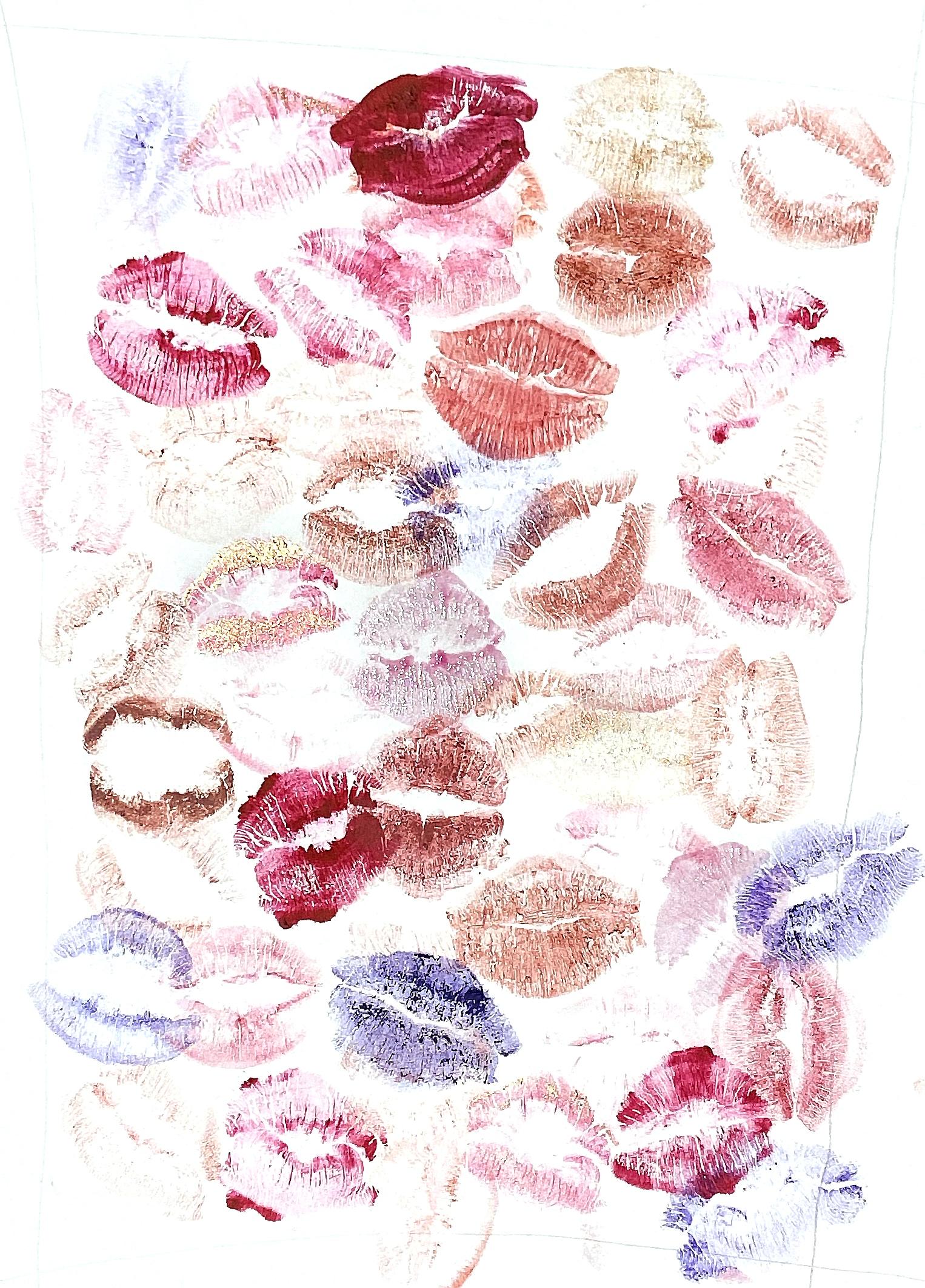
Renaissance of Riot Grrrls
“ISwearIt’sGood”

Dates and golden syrup. A little sweet combo that marries the creamy, nutty, caramel notes of the date with the tang of the golden syrup’s sweetness. While the date can stand up on its own for sweetness, holding a characteristic chewy toffee taste that we associate with the pudding, by adding the syrup, it boosts the toasted flavours. Simply open up the date, remove the stone and squeeze the syrup on and it’s an energy boost in a mouthful, tasting better than having a piece of fudge. So far so good right? Now here’s the twist, sprinkle a bit of nutritional yeast on top. It feels so wrong, but it adds an umami, salty hit to a sweet treat, and doesn’t have the bitterness of coarse salt. The yeast’s cheesy mellow notes tames the sweetness, creating something that is an unexpected, slightly shameful, flavour bomb.
words by: Ellen Hollingshurst

Crazy Food Combos
Drunk food combinations have the potential to become a guilty pleasure. Sometimes the Mama’s queue is too long so you raid your cupboards for anything to fill your cravings, only to find half a can of sweetcorn, 3 chicken nuggets and a half mouldy wrap (happens to the best of us). For me, I came home to find peanut butter, a smidge of grated cheddar, 3 slices of sourdough, and a single slice of ham. Unable to choose between a cheese and ham toastie or peanut butter toast, I decided to combine both. This may sound vile, but it resulted in the best toastie I have ever consumed; the sweet peanut butter mixed with the salty ham and cheese tasted better than any late-night kebab. Despite many attempts since that fateful night in April, I have never since been able to recreate such a delicious drunk scran, but it lives on in every toastie I make.
words by: Katie Brosnan
As a self-proclaimed food snob, this is slightly shameful to write. But everyone has a weird food they like, so please don’t yuck my yums – I promise they’re good if you give them a chance... The first is pasta with baked beans. My flatmates bully me relentlessly for it, but it is so good. There’s an art to it – Lidl’s finest (own brand) baked beans with spaghetti and HEAPS of cheese melted into the beans. The second and grossest on paper is cheese and mayo. That’s it. A slice of cheese with mayonnaise on. There’s something about the textures that just work so well together, it’s like a sandwich just without the bread (however, the more mayo, the better). An honourable mention to my flatmate’s favourite postnight out snack that I have mixed into my rotation – a tin of tuna mixed with gherkins (does the hangover NO favours however).
words by: Hansa Tote design by: Alanya Smith photography by: Adam Breen
Food & Drink
36

Baking Is My Part-Time Life: An Insight Into A Micro “Influencers” Life
I will never personally call myself an influencer, mainly because I can see that 95% of my followers consist of robot accounts and my friends and family who follow for pity’s sake. However, the remainder of those followers who constantly like, comment and interact with my feed push me to continue my page. Deep down I know it fuels my people-pleaser personality, however, the love they share on my most mundane bakes, lights me up every time phone gets a notification. They give me a sense of belonging I have always struggled to find around other people and make me feel a part of this wider community of bakers out there.
Baking has always been a part of my life; I grew up in a household where we would have homemade peanut butter cookies after school instead of a packet of crisps or a chocolate bar. I have my mum to thank for that, for she has imbued my whole life in the wonderful world of baking, opening up my childhood palate to spices, comfort food and treats that aren’t just “sweet”. Looking back now, I can distinctly remember baking our family Welsh cakes together (I say “we” but realistically I sat on the countertop, eating raisins out of the raw Welsh cake dough) and passing the time busying ourselves in the kitchen. As a result, baking has become a part of my love language, for I adore how I can light up my mum’s face after a long day at work with a treat. Not to mention the secret glee I feel when my dad loudly scoffs a plateful of treats. And when I’m away from home, I turn to my baking society, where I can revel in the comments a cake can get. While this is a slightly toxic trait I’d admit, I have nowadays started to bake for myself, to discover new flavor combinations and textures I enjoy, and will make a delicious treat after a long day at university.
and ancient history, which back then seemed a polar opposite to baking, and made me think my whole life was going to be decided upon through choosing one or the other. Do I go into academia and make sure I can make a living but not know if I will truly be happy? Or do I leave it all, go rogue and bake knowing I may fail and not be able to earn a living? Spoiler alert, I ultimately stuck my head in the sand and went with university, however I don’t regret it slightly. Not only because I wouldn’t be able to afford to make a living out of baking, but by coming to university, I met my baking society, who encouraged me endlessly throughout my first year - which was especially difficult if anyone knows the state of the Talybont kitchens. Progressing into second year, a good camera, knowledge of how lighting actually works (I hate some of those initial photos so much!), and a basic understanding on reels has allowed my account grow, whilst the discovery of ‘food history’ within my academic life has revived an interest in my degree. Ancient Roman cheesecakes, eggy breads and custards made of brains, weirdly gives me hope that I will one day be able to combine my two loves into a livelihood.
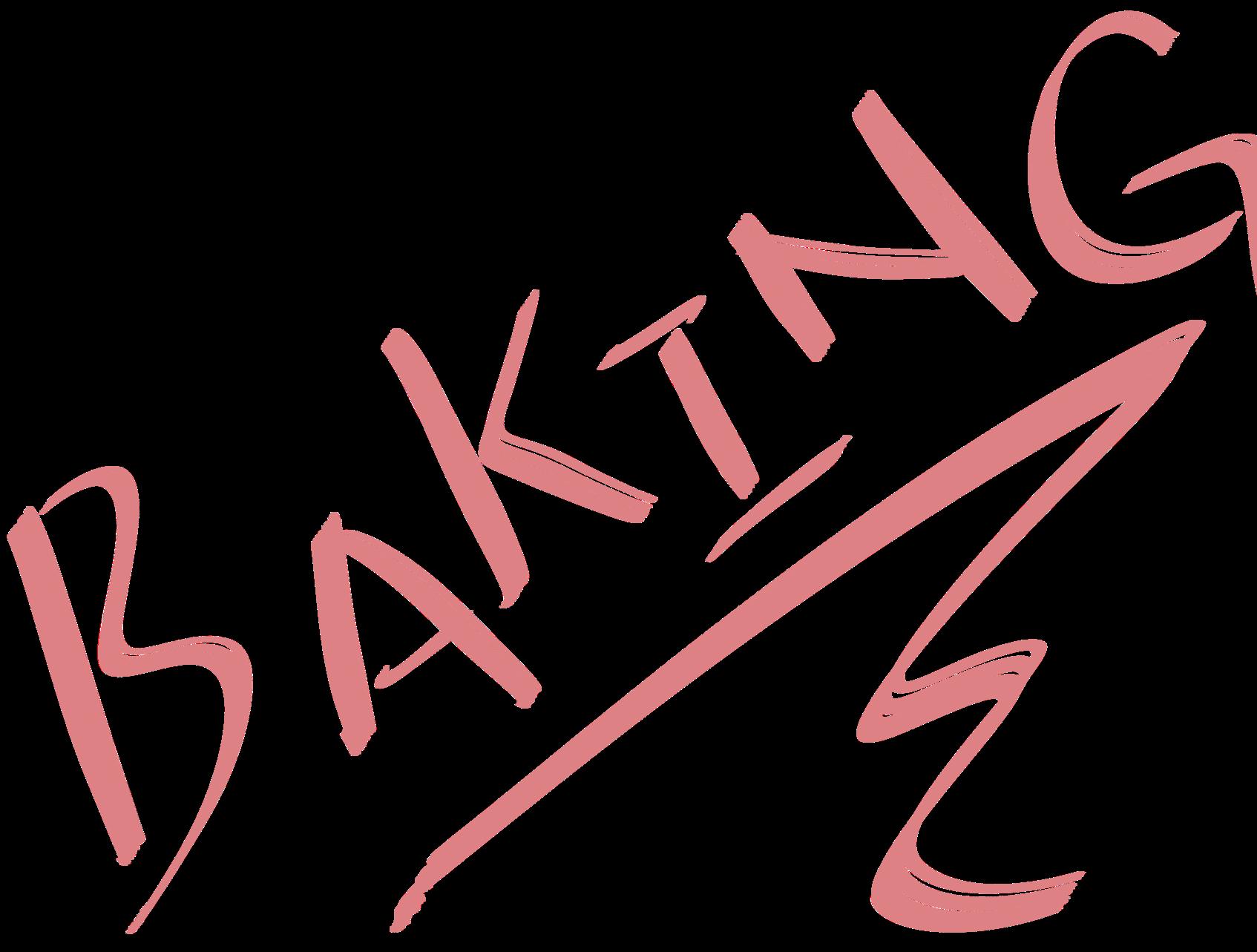
My Instagram (@a_bakingmess), is the child of this passion and love. Created just before I began university with a few pretty (but rudimental) pictures, it placed me in a difficult position between a passion for baking and an academic pride/ pressure pushing me to pursue a university degree. For reference, I study archaeology
Until such a dreamy future comes true, I’m feverously baking away in the kitchen and becoming best friends with my freezer. I’m whipping up cookies, cakes and bread like no-one’s business. Constantly creating content for Instagram, feeding my endless sweet tooth, and as a stress reliever as the essays start to stack up. I see my baking as an investment into my wellbeing, because it really helps to beat the life out of some batter and punch some bread. And when I have rammed the freezer full, and have to press pause on baking I turn to my art to fuel my obsession with food. Whether it’s to get a concept out of my brain or to produce a commissioned piece of art for someone, it allows me to zone out of university stress. So, I may not be a famous Instagram baker, but I am baking for the love of cake .(please feel free to DM me @a_bakingmess for more information about personalizes art, recipe pages or even prints of my photographs).
words by: Ellen Hollingshurst design & illustration by: Alicia Yap
37
Food & Drink
Pasta Evangelista Review
Can I boil pasta myself? Yes, but not this way. My takeaway go-to is Pasta Evangelists. The Cardiff branch of this national delivery chain is located in the heart of the city; their delivery radius encompasses a majority of student housing. Everything on the menu is less than £15, including my favourite, the lobster, crab and prawn ravioli which comes in at £13.75 and is audaciously delicious. At the end of a long day, when I want a little treat, they throw in a free gift for orders over a certain amount. So if you fancy a rich, creamy tiramisu or some fresh focaccia, it’s on the house. Their online delivery service offers all kinds of discounts and deals, but they are also available on Deliveroo with a myriad of gluten free and vegan options.
words by: Sabine Wilson-Patrick
Working in retail means that, most of the time, you don’t get home until late. And, most of the time, getting home late means absolutely zero motivation to do anything but put your pyjamas on and re-watch old medical dramas

I haunt the Uber Eats app on a nightly basis, and (rather embarrassingly) pay for Uber One to further support my crippling food addiction. Since moving to Cardiff, I have had one, true love – one constant – and that is Albany Fish Bar. Don’t just take my word for it – its Lady Gaga’s favourite, too. And for good reason. I love a chippy tea, and Albany take it to the NEXT LEVEL. It’s cheap, and fast, and so, so Tasty. Large chips (with lots of salt and vinegar) and Irish curry, you have my heart. I will miss you so much when I go.
words by: Tegan Davies
a crispy thin base with a thick crust. With so many toppings to choose from you’re spoilt for choice. I always gravitate to number 6. Crispy cured chorizo paired with fresh mozzarella and a flavourful, sweet tomato base. With pizza starting at only £8.40, there’s so much to love.
words by: Pollyanna Rees design by: Alanya Smith
Food & Drink 38
Yn
Gad Dy Glebar
y rhifyn yma, mae Llŷr Eirug am cau eu glebar!
Beth yw dy enw? Llŷr Eirug
Beth mae dy ffrindiau yn dy alw di? Llŷr
O ble wyt ti’n dod? Aberystwyth
Tri gair i ddisgrifio dy hun? Cymdeithasol, Uchel, Cyfeillgar
Pa gwrs wyt ti’n ei hastudio ac ym mha flwyddyn wyt ti? Cymraeg a Newyddiaduraeth ac yn fy ail flwyddyn
Ble byddwn ni’n debygol o ddod o hyd i ti ar nos Sadwrn? Clwb Ifor Bach
Beth yw dy ‘hangover cure’? Pydri yn gwely neu ordro bwyd ar deliveroo
Hoff beth am ddinas Caerdydd? Prysurdeb y ddinas
Beth yw dy ‘go to drink’ ae noswaith allan?
Corona a lime neu pink hooch
Hoff beth am fod yn Gymro/Gymraeg? Y diwylliant
Beth yw un arferiad gwael sydd gennyt ti? Cysgu trwy alarms
‘Tip’ byddech chi’n rhoi i fyfyrwyr blwyddyn gyntaf? Avoidwch deliveroo
Beth yw un cyfrinach sydd gennyt ti? Ma’n gyfrinach am rheswn!
Hoff gân? Silver lining lead balloons gan Gruff Rhys
Pwy sydd angen cau eu clebar tro nesaf? Osian williams
darluniwyd gan: Mia Wilson



Clebar 39
Gwrthryfel Hanesyddol
Un o’r momentau mwyaf gwrthryfelgar yn hanes Cymru oedd Rhyfeloedd Glyndŵr, sydd wedi adlewyrchu fel symudiad gwrth-droid cysoniad a gweledigaethol iawn yng nghalon y genedl. Dechreuodd y rhyfeloedd hyn yn y 15fed ganrif pan arweiniodd Owain Glyndŵr y gwrthryfel yn erbyn awdurdod Lloegr, gan ymgyrchu dros annibyniaeth Cymru. Yn 1400, dechreuodd Glyndŵr ei ymgyrch am annibyniaeth Cymru, gan gynnal gwrthryfel yn erbyn y brenhinoedd Saesneg. Cyfansoddodd Glyndŵr seremonïau brenhinol ei hun ac ennill cefnogaeth y gwladwriaethau Celtaidd eraill. Yn fuan, cyhoeddwyd deddfau cadarnhaol yn sefydlogi buddiannau Cymru.
Yn ystod y rhyfeloedd, cyflawnwyd llwyddiannau sylweddol o dan arweinyddiaeth Glyndŵr, gan gynnwys gorchfygiad ardal gynyddol o dir Lloegr a derbyn cefnogaeth rhyddhau Cymru gan frenhinoedd estron megis Ffrainc. Yn ogystal, cyflwynodd Glyndŵr ddeddfau newydd i ddiogelu iaith a diwylliant Cymru, gan ennill cefnogaeth y boblogaeth leol.
Er nad oedd ymladd Glyndŵr yn llwyddiannus yn y pen draw, fe greodd y rhyfeloedd ysbryd o ddewrder a hunaniaeth genedlaethol yn nwylo’r Cymry. Erbyn iddo farw, llwyddodd Glyndŵr i gyffroi cenedlaetholdeb Cymru ac ennill parch y genedl am ei ymdrechion gwrth-droid.
Gyda’i ysbrydoliaeth a’i arweinyddiaeth, parhaodd y weledigaeth o annibyniaeth Cymru i fyw, ac mae enw Owain Glyndŵr wedi aros fel symbol o’r frwydr dros annibyniaeth a diwylliant Cymru. Yn dilyn y rhyfeloedd, datblygodd Cymru fel cenedl sy’n annog iawn dros annibyniaeth a chyfiawnder cymdeithasol. Mae’r hanes hwn yn ailadrodd y pŵer a’r grym sydd gan bobl Cymru i herio diwylliant ac awdurdodau estron a chreu tirwedd newydd o hunaniaeth genedlaethol.
ysgrifenwyd gan: Caitlin Griffiths darluniwyd gan: Alanya Smith
Un o’r mudiadau sydd yn dod i’m mhen yn bennaf fel digwyddiad gwrthryfelgar yw Merched Beca.
Yn ystod y 19eg ganrif, peiliodd Merched Beca ar draws y cefn gwlad Cymru, gan chwarae rhan hanfodol yn ymgyrch dros gyfiawnder a chydraddoldeb. Roedd y mudiad hwn yn bennaf yn gwrthwynebu’r costau uchel o barchu yng Nghymru, lle’r oedd y system rent troseddwyr yn arwain at hawliadau am y telerau economaidd a chymdeithasol isel iawn.
Gyda’r mudiad, dechreuodd merched ifanc o ardal Sir Gaerfyrddin a Sir Benfro gwisgo dillad dynol i guddio eu hunain wrth fwrw gwrthryfel yn erbyn costau uchel y tollwyr, lladratawyr, a landlordiaid dir. Yn ogystal â chyflwyno gwrthryfel hiliol, roedd y Merched Beca hefyd yn gweithredu mewn modd trefnus, gan ddewis targedau’n ofalus ac yn aml yn dewis targedau o’r dosbarthiadau uwch.
Er mai’r mudiad oedd yn bennaf yn dod o fErched tlawd y ffErmydd a’r diwydiannau croesawyd cefnogaeth eang gan wleidyddion, diwydianwyr, ac arweinwyr addysgol
Yn sgil hyn, dechreuodd cyfryngau Cymru arwain sylw at weithgareddau Merched Beca, gan adrodd ar eu gweithredoedd ac effaith.
Ar draws Cymru, byddai’r Merched Beca yn cynnal gweithgareddau fel taflu nwy a chael eu harestio am ddefodau lladrataodd. Er mwyn cydymffurfio â’r angen i guddio eu hunain, cyhoeddwyd llyfrau a chanu cerddoriaeth Gymraeg. Yn ogystal, fe gynhaliwyd rali gyhoeddus fawr yn Aberystwyth a fu fforchwn bennaf am dri dydd o oroesi ymgyrchai’r Merched Beca.
Er nad oedd y mudiad yn hollol lwyddiannus yn ei nodweddion, fe allai effaith Merched Beca ddyfodol Cymru fod yn sylweddol. Mae eu hymdrechion wedi helpu i gryfhau cymunedau cymunedol a’u galluogi i fynd i’r afael â materion economaidd ac ymwybyddiaeth o’r angen am gyfiawnder cymdeithasol. Yn olaf, mae enw’r Merched Beca wedi aros fel symbol o frwydr dros gyfiawnder cymdeithasol ac economaidd yng Nghymru.
Mae’n stori wrthryfelgar sydd yn cael ei adrodd ym mhob gwers hanes ar draws Cymru a chredaf allan ni dysgu llawer o ymlyniad a’r brwydro yma!
ysgrifenwyd gan: Bethan Rocke
Clebar 40
gydraddoldeb
Protestio’r Iaith Gymraeg
Mae protestio’r iaith Gymraeg wedi bod yn rhywbeth sydd wedi bod yn cymryd drosodd ein cenedl am ganrifoedd ac yn parhau i ddigwydd hyd heddiw – felly mae’n ddiddorol i weld os oes newid wedi bod yn y ffyrdd o brotestio ac od yw’n cael ei weld fel gweithgaredd gwrthryfelgar?. Gawn ni weld...
Am y 50 mlynedd diwethaf mae ‘Cymdeithas yr Iaith’ Gymraeg wedi bod yn arwain y ffordd i hyrwyddo a diogelu’r iaith Gymraeg. Mae’r grŵp yn anelu at gydraddoldeb mynediad at yr iaith ac yn ymgyrchu yn gadarnhaol mewn ffordd ddigyfaddawol dros hawliau pobl yng Nghymru i ddefnyddio’r iaith ym mhob agwedd o fywyd bob dydd. Mae dulliau protest wedi cynnwys eistedd lawr, streiciau newyn a hyd yn oed ymosodiadau, ac ers y blynyddoedd mae wedi denu sylw enfawr gan y cyfryngau. Yn aml, cynhelir rali gyhoeddus lle mae pobl yn dod at ei gilydd i fynegi eu gwrthwynebiad tuag at ymyriadau anghyfiawn â’r Gymraeg gan awdurdodau neu’r llywodraeth. Mae’r rali hon yn amlinellu llais cymunedol a’r galw am weithredu uniongyrchol. Wyneb cyhoeddus sydd wedi cael ei weld am flynyddoedd o fewn ralïau yw Dafydd Iawn i ddangos ei gefnogaeth.
Fe wnes i gael y profiad o fod yn dyst i brotest ‘Cymdeithas Yr Iaith’ yn yr Eisteddfod Genedlaethol llynedd lle wnaeth y protestwyr fandaleiddio pabell y Llywodraeth trwy osod posteri ar yr holl du allan. Fe wnaeth hyn agor fy llygaid trwy hefyd profi fod yr ymladd a phrotest ar gyfer ein hiaith yn dal i fodoli yn gryf. Mae Dafydd iawn wedi bod yn gymeriad pwerus o fewn protestio Cymru a ddefnyddiodd ei gerddoriaeth a’i lais i drawsnewid ei gefnogaeth dros yr iaith Gymraeg

Gan gyfansoddi caneuon fel “Carlo” a “Yma o Hyd”, adeiladodd ymdeimlad cenedlaetholgar a gwrthrychol tuag at gynnal a diogelu’r iaith.
“Yma o hyd” - can llawn angerdd a phŵer. Yn 1983 ganwyd y can ar adeg o drychineb gwleidyddol ac economaidd yng Nghymru, lle gwelwyd llawer o lofaon glo yn cau a miloedd o ddynion a menywod yn colli eu swyddi o ganlyniad. Mae’r can yn gyfeiriad at oroesi diwylliant ac iaith Cymru er gwaetha’r cyfnodau anodd hyn. Fe wnaeth can mor syml cael effaith mor enfawr ar brotestio yng Nghymru.
Mae wedi bod yn anthem gyfarwydd i siaradwyr Cymraeg ers peth amser, ond mae Yma o Hyd Dafydd Iwan wedi cael cyfnod newydd sbon yn dilyn yr 2022 ym Mhencampwriaeth y Byd, gyda chefnogwyr ledled y wlad yn canu’n uchel amdano ym mhob cyfle bron i 40 mlynedd ar ôl iddo gael ei ysgrifennu. Felly, mae’n glir i weld fod llawer o brotestio’r iaith wedi aros yn draddodiadol, ond hefyd yn parhau i godi’r cwestiwn os yw’n wrthryfelgar neu’n angerddol..
ysgrifenwyd gan: Bethan Rocke
ffotograffiaeth gan: Adam Breen
darluniwyd gan: Alanya Smith
Clebar 41
angerdd drychineb cyfnodau wrthryfelgar
cymunedol rali

 photography by: Laura Nunez
photography by: Laura Nunez
 photography by: Adam Breen
photography by: Adam Breen
Growing up as a girl comes hand in hand with feeling the burden of shame. Whether you’re getting dress coded in school or getting teased for being “boy crazy”, shame follows you through it all. And as sad as it is to admit, experience is always the best teacher. When you grow up and start slowly piecing things together, gauging how the world around you works, only then you realise what shame really is. You start seeing how guilt and shame are the ultimate tool to control. A woman who is afraid is more malleable. Society makes girls feel inadequate for doing things that make people uncomfortable without stopping twice to think about how they might feel.
Rebelling Against Shame
In my 20s, my sex life has unsurprisingly taken the spotlight. There is nothing that makes people more uneasy than a woman who is open and bold about their sexuality. Because as far as we have been taught, sex is impure and anyone who partakes is inherently immoral. So how could a woman possibly embrace her promiscuity? Well, it becomes an easy thing to do when you realise that at the end of the day what matters is what makes you feel personally empowered and fulfilled. I will no longer succumb to the subtleties of being asked about my ‘body count’ or ‘jokes’ about being a ‘slut’. The turning point is understanding that who I sleep with has no relationship whatsoever to my worth as a person. Now, in a satisfying turn of events I get to see the disappointment in people’s faces when their attempts to shame me only bounces off me right back to them.
words by: Natalia Murcia Cencerrado
To me, ‘shame’ is not merely an emotion, but the experience of a made-up concept of social society. It is purely based upon a grounding of what is currently considered socially acceptable, however niche, ethical or simply one’s opinions against another’s. These norms tend to fluctuate with trends, and at its root, the established need for power of superiority over those who are being ‘shamed’ upon a social ladder. As such, the idea of shame is most prominent in social situations such as social media, schools, or workplaces.
It is in our programming as humans to experience emotion, and shame has got to be one of the worst of them, it induces an inner self-critique and mentality of comparison, guilt and regret against those who shame you for a particular reason. Yet, it is something that we all share as an experience throughout our lives, therefore, why should we be ashamed of this shame, and how do we overcome it?
I strongly believe that the pathway to the rebellion of shame is independence. Especially in our digital climate, it is so easy to shame or ‘cancel’ one’s actions online, if you look for it, there will always be a critique or comparison of another
for their actions or lack of, or even physical possessions or appearances. Therefore, self-appreciation is key to rebelling against the parallel dynamics of comparison and shame. It is a social disease, so if the nucleus of the context is reduced or removed, there is only room for development.
Especially in today’s society, there is a stigma of shame surrounding taboo topics such as sexuality, or identity, which is not only morally wrong but diminishes one’s identity down to the way they were born. Again, shame is a madeup concept that survives based upon others’ desire to gain social power, so there is should no shame in being yourself or appreciating your interests, despite the ever-fluctuating social norms. Refusing to be ashamed is to rebel against the system itself.
words by: Sam Davies
Maybe it was the hormones, that pesky teenage angst that creeps up on all of us at the pinnacle of our lives – but I genuinely always felt different growing up, and harboured an excessive amount of shame as a result.
In truth, I had no idea it was down to neurodivergency – I had always felt like the outside recipient of the most hilarious, complex and worldwide inside joke. I did not know how to like things a normal amount, and so displayed a considerable amount of passion for each and every interest I developed. Long story short, I was the emo, queer kid, and going to a Catholic school with such a label plastered above your head meant you were pretty much fending for yourself at the age of eleven.
It took me a long time to come to terms with who I was. The rampant bullying and consistent turmoil I experienced made it difficult to look in the mirror. In some form of counselling since the age of nine, I suppose I still haven’t quite figured out how to rebel against the social hydraulic press that is so precise in its acceptance. I do know, however, that I am proud to be who I am. I am openly bisexual, no longer the girl that changed in the toilets to avoid the whispering, the shuffling, the dirty looks. I listen to the same music I did a decade ago and recite the lyrics as though they are my own personal creed. But do I still gulp when certain individuals pop up on Facebook? Do I refresh continuously once posting on Instagram? Most definitely.
Shame is a lesson difficult to un-teach, and to an extent I do not believe anyone will ever shake that subconscious echo so familiar to school hallways and KiK chats. As they say, we are a product of everything we have viewed, heard, experienced. And I think, for now, the biggest rebellion against that shame is to continue to live through it.
words by: Tegan Davies design by: Alanya Smith
Spotlight 44
beyond THE PILL
Acne, mood swings and headaches: the reasons behind the choice not to continue a trial for the male sex birth control pill in 2016. This may seem ludicrous to those of the opposite sex who must navigate a myriad of potentially serious side effects in their necessity for contraception. Blood clots, nausea, increased risk of cervical and breast cancer, stroke, heart attack, depression and anxiety are just some of the harmful effects possible when taking the contraceptive pill.
The issues don’t stop there as the options for modern contraceptives vary greatly. One can choose from implants, injectables, patches, vaginal rings, intra uterine devices, condoms and female sterilisation. This may seem overwhelming and that is because it simply is.
Many are turning their backs on modern day contraception as a rejection of the mainstream. If the only contraceptive options available to the female sex are ones riddled with negative consequences, then why would we continue to tolerate them?
There has been a significant increase in alternative contraception methods. A 2021 study from the journal of Social Science and Medicine cited the reason for this rise is linked to a demand for naturalness and women expressed a desire to regain control of their own bodies.
One of the ways women are regaining control of their bodies is utilising natural cycles. The ‘rhythm method’ tracks ovulation dates to work out when you are most likely to become pregnant. You’re truly communicating with your body, feeling your way around your fertility and natural hormones. This method of contraception feels almost ancient in its execution.
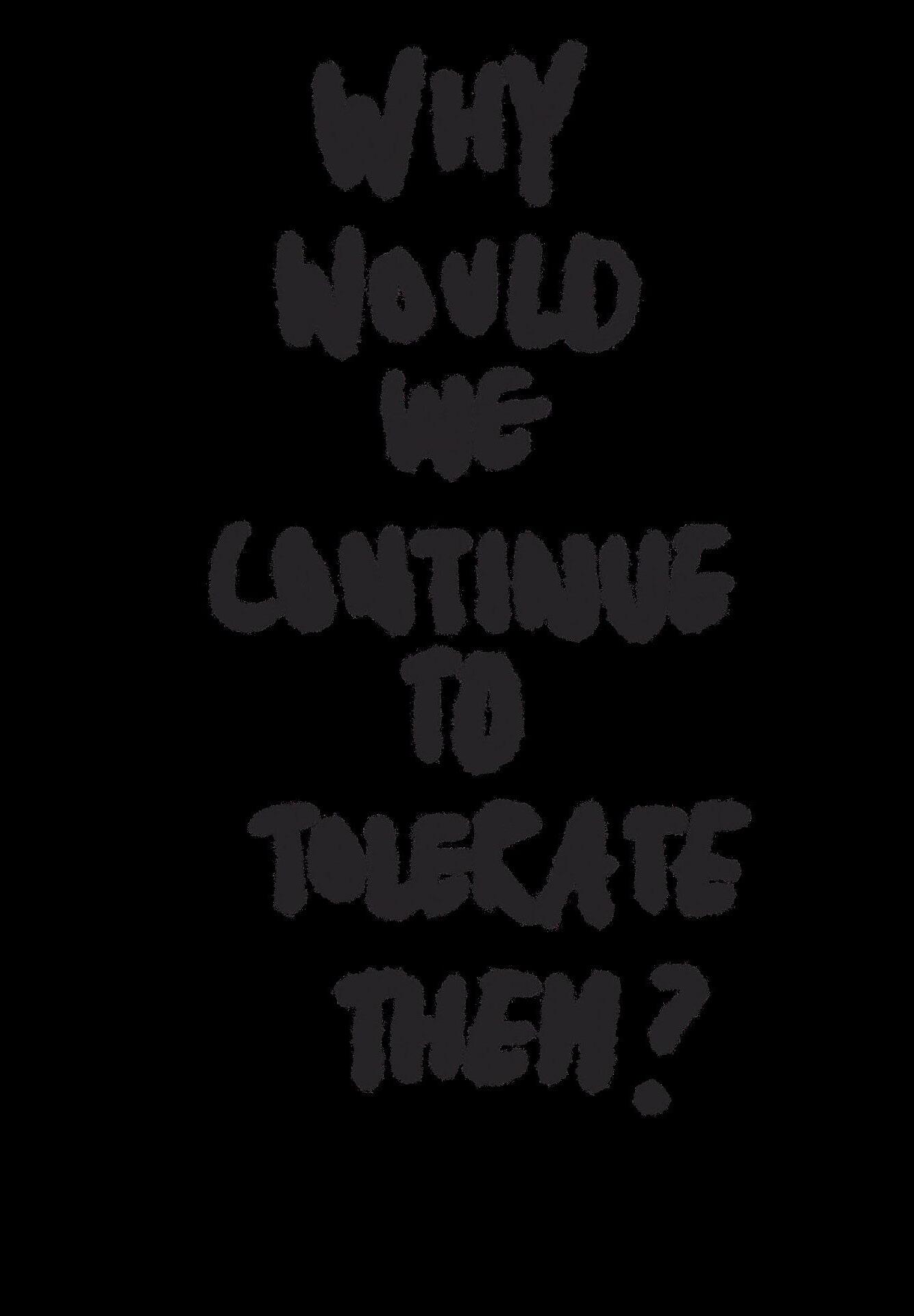
It could be likened to the 22,000 year old lunar calendar found in the Congo. The Ishango Bone was found with 28 incisions carved in it. It was initially considered to be man’s first attempt at a calendar. But eventually a scholar asked the all important question: why would a man need to mark 28 days? It is now deemed to be the earliest menstrual cycle tracker and we are still doing it today as women embrace natural cycles.
The Oura Ring also uses the bodies natural cycles. The Oura Ring is a comprehensive health tracker than can you a daily update on your fertility rate and when you are most likely to be pregnant. This gives individuals control over their bodies without the need to submit to contraceptives with awful side
This rejection of mainstream contraception and embracing of new natural methods could come from the overall lack of essential research into women’s biology. Biology is largely built for the male sex. Male bias is extremely prevalent in the medical world. Medicine has always seen women first and foremost as reproductive bodies and medical trials time and time again do not use female participants resulting in a huge gap in medical knowledge for women.
Many are now rebelling against this in favour of taking back control. Why would half of the population continue to trust and tolerate a medical industry that continually dismisses, harms and abandons
Georgiana Smith design & Illustration by:
45 Spotlight
Making The first move
Is It Still A Man's World?
It’s a man’s world, right? I’m sure I’m not the only one who was raised to believe a woman should be demure, letting the man make the first move; but in the 21st century, do we all still conform to that ideal? Are men now more attracted to forward women? How does this power shift change the dating game?
Women have long been objects of male pursuit, but that does not necessarily mean we have to sit silently, waiting to be approached any longer. In the United States, the renowned Sadie Hawkins dance flips gender roles around, pushing girls to make the first move. Originating in the late 1930s, it allowed women to feel permitted to ask men to dance.
The tradition of Sadie Hawkins still runs strong in traditional Southern high schools, but many more contemporary schools across the country have disbanded the dance, claiming it’s outdated. For its time, the Sadie Hawkins dance was innovative and empowering, opening the door for women to do as they wished without the taboos of gender norm enforcement. We have come a very long way since then. With technology, there’s a whole new expectation and realm of dating that would send any 1930s teenage girl into cardiac arrest.
In 2024, we have new methods of exploring the dating pool. With online dating, we all supposedly hold equal power over our interactions. However, just because a system is created to be equal, does not necessarily mean that it is. On Tinder, the man-to-woman ratio is grandiosely skewed with only 24% of users identifying as female and 75% identifying as male.
The disparity of equal opportunity favours the women in this case. It provides a girl with a myriad of suitors to pick
from, although it is often hard to find the diamond in the rough! Bumble is an app directly created to put the power in women’s hands. Bumble works, much like Tinder, by matching people who show mutual interest in one another.
The twist, however, is that instead of providing both parties with an opportunity to make the first move, Bumble exclusively allows the woman to approach the man. Not only does this limit the occasional creepy one-liner, but it also puts any girl at an advantage by setting the tone for the conversation. This may be an intimidating feat, but I promise that making the first move will only benefit you. You hold the power!
Men love confident women. In my case, my boyfriend has reflected on the early days of our relationship, and he always says he loved how I wasn’t afraid to ask him out or take initiative. Any secure man should not be afraid of a woman who knows what she wants, especially one who’s not afraid of going after it. Does this mean that all of us women must be go-getters and chase every man? Definitely not!
This is only to say: don’t hold yourself back from opportunity because of fear or discomfort. If you like someone, seize the moment! Don’t simply lie around waiting for them to make the first move. It’s a courageous and admirable thing to put yourself out there, even if things don’t work out.
My motto for dating and going on a night out is the same: prepare for the worst (but don’t expect it!) and hope for the best. The worst they can say is no. If they do say something horrible, they weren’t worth your attention in the first place! The moral of the story is that you’ll never score if you don’t at least shoot your shot.
words by: Carolina Domingues design by: Billy Edwards
Spotlight
46
The Masked Feminists
The Guerilla Girls At The Vanguard Of Art Rebellion
Art is a powerful medium, and arguably the most effective form of rebellion. Through art, people have always been able to express ideas, question social norms, and challenge the status quo by rebelling against what is ‘typical’ and ‘accepted’.
The Guerrilla Girls were an anonymous group of feminist artists that first came together in New York in 1985, and famously wore monkey masks to keep themselves anonymous whilst fighting gender and racial inequality in the arts. The gang was known for their use of ‘culture jamming’ in which they used a variety of anti-consumerist initiatives to disrupt mainstream media such as corporate advertising. They employed culture jamming in the form of posters, books, billboards, interviews, lectures, internet interventions and public appearances to expose gender and racial disparities and discrimination within the art world. In particular, they often used ironic humour to add layers to the meaning of their work and enhance the engagement of their serious message. Whilst initially focused on feminist campaigning in the arts, a year after its founding the group expanded their mission to target racism in the art world, which attracted artists of colour towards their project. The group later took on projects outside of New York which allowed them to address sexism and racism internationally as well as nationally.
From the outset, The Guerrilla Girls have maintained their anonymity throughout their activities as a form of symbolic rebellion against the press who had wanted pictures of the group. The use of a monkey mask hilariously came from one of the original members misspelling ‘guerrilla’ as ‘gorilla’. Moreover, when subjected to the public eye in public settings such as in interviews, the members used pseudonyms of famous deceased female artists, writers, and activists such as Frida Kahlo and Harriet Tubman, which helped them conceal their individual identities. Whilst the Guerrilla Girls formed in 1985 and only ever intended to be a temporary organisation to uncover gender disparities, across the years in which they were active the group had grown to a total of 65 members.
The Art World During The Pre-Guerilla Uprising
Throughout the history of art, female artistic and curatorial representation in art galleries has been undeniably sparse. Museums such as the Metropolitan Museum of Art in New York were often privately funded by elite white males, and the content in museums reflected this perspective. Museums became a documentation and display of patriarchal power structures; whilst some female artists were on display, female representation or female art tended to be mostly nudes, which further pushed the misogynistic perspective of the museums and the art world.
Laying The Foundations
In a 1984 exhibition by the Museum of Modern Art ‘An International Survey of Recent Painting and Sculpture’, a total of 165 artists were on display, with only 13 being women. A small proportion of these 165 artists were artists of colour, yet none of them were women of colour. In the spring of 1985, the Guerrilla Girls was started by 7 women as a blunt response to this exhibition and the audacity of the board and curators. The initial founding women of the Guerrilla Girls were all white women who participated in protests led by the Women’s Caucus for the Arts. These protests were largely ignored, which led the gang to seek out a more media savvy method of reaching the public. Thus the Guerrilla Girls turned to conveying their messages by using wheat-pasted posters in downtown Manhattan. They focused their attention in the SoHo and East Village neighbourhoods, as they were home to both artists and the commercial galleries that served as their initial targets.
The Guerrilla Girls stand as an exemplary model of artistic rebellion as a means to challenge the status quo. Harnessing the power of anonymity and maintaining focused and united as a group, the Guerilla Girls have left their paint marks of rebellion not only on the artistic canvas, but on the pages of history.
words by: Bhamini Khandige design by: Alanya Smith
Culture 47



48 Culture

students from Harvard, Boston, and Radcliffe universities in the United States held a four-day hunger strike in protest. With many other students participating in their own protests around the globe, this anti-war movement became part of a more significant movement against the traditional attitudes and values in America.
Around this time, there were many female liberation movements in the UK and the US. Known as ‘second wave’ feminism, the social movement sought equal opportunities and rights for women. This ‘second wave’ movement had different groups of women with various ideas about achieving liberation. Liberal feminists protested for better equality laws, whereas radical feminists argued that the most significant cause of female inequality was the patriarchy. With many women confined to the home at this time, many protests went underway for women to be more represented in universities. Helping to forge a new sense of female identity through shared experiences, later movements such as ‘Me Too’ which grew into prominence in 2017, tackled similar issues.
Another example of student protests was the youth strike for climate protests in 2018, led by Greta Thunberg. Predominantly participated by school-aged students, university students joined the ‘school strike for climate’ protests in the summer of 2018 and 2019. With events being scheduled in over 163 countries, this was the largest climate change protest, especially by students. While Greta is the most well-known young climate activist, many students strive for action worldwide. If progress in climate change occurs, young people, especially students, will drive it.
As a whole, if you ever hear of a protest going on, never be surprised if it is the youth of today who are behind it.
words by: Amelia Wollacott design by: Alanya Smith
Culture 49


51


Welcome To Quench Beyond...
where the postgraduate experience takes centre stage!
Quench’s PG Representative and deputy editor, lucia cubb!

Beyond 52
Hi everyone! As you may have seen online, we’re super excited to announce the launch of a new section – ‘Beyond’. Beyond is Quench’s postgraduate section – for master’s students, written by master’s students. We are aiming not only to diversify our content but also to ensure that the postgraduate scene is well-represented and celebrated!


What to Expect from Quench Beyond
One of the most important things we are aiming to do as part of Quench Beyond is be as clear and honest about what it’s like being a postgraduate student. From insightful articles on navigating the world of advanced learning to more personal stories of triumphs and struggles, we can’t wait to capture the essence of life beyond the undergraduate journey. Showcasing the unique perspectives, achievements, and challenges faced by master’s students is our main objective.
words by: Lucia Cubb design by: Alanya Smith

Join Us on the Journey
Whether you are a current postgraduate student, an spiring master’s candidate, or simply curious about the postgraduate scene, Quench Beyond wants you to join us on this exciting journey. We want to hear all about your stories, insights, and ideas – let’s create a community that amplifies the richness of the postgaduate experience.

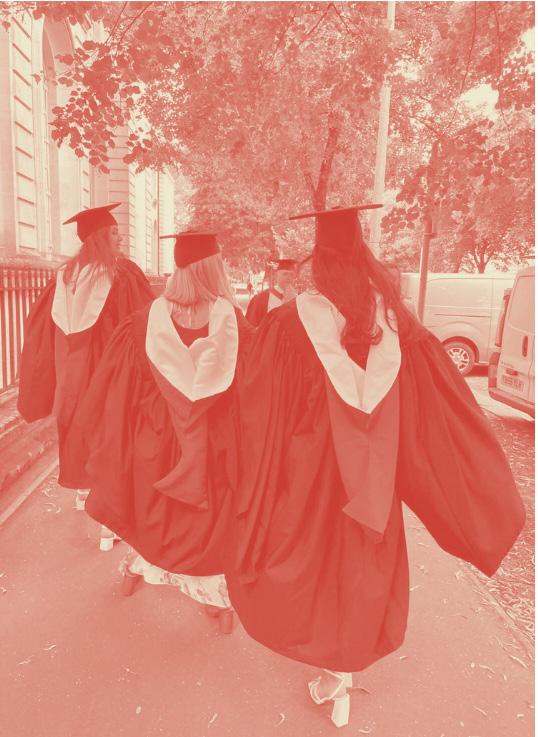
Beyond 53

 photography by: Mia Wilson
photography by: Mia Wilson

Tan tro nesaf.




















 photography by: Laura Nunez
front/back cover & design by: Mia Wilson
back cover modelling: Tom Hewitt
photography by: Laura Nunez
front/back cover & design by: Mia Wilson
back cover modelling: Tom Hewitt











 photography by: Adam Breen
photography by: Adam Breen









 photography by: Adam Breen
photography by: Adam Breen


 photography by: Laura Nunez
photography by: Laura Nunez
 words by: Sam Davis design by: Elinor Pyman
words by: Sam Davis design by: Elinor Pyman











 photography by: Laura Nunez
photography by: Laura Nunez
 photography by: Adam Breen
photography by: Adam Breen














